About Attica
Attica’s History
Steeped in war and intrigue, culture and myth through the ages, it’s easy to see how Attica & Athens became the heart of the civilised world. Their rich history is very much evident today as you take in the sights and sounds of Athens, one of the many key cities in the region. No other area can lay claim to so many historical events and important cities as Attica. Indeed, it is in cities such as Eleusis, Megara, and Marathon that democracy, philosophy, and poetry -all Greek words, by the way, originated.
War was also commonplace, and it was at Salamis and Plataies that the fate of the free world was determined when the Athenians met the Persians and emerged victorious. Having inspired many Hollywood blockbusters – including 300, the epic about the Battle of the Hot Gates and its prequel Xerxes – this era of Greek history cannot but spark interest.
The Athenians fought Darius and his invading forces without the help of Spartan reinforcements. The Persian defeat was so decisive that no further attempts were made to invade Greece for many years. Miltiades’ brilliant strategy at the battle known as The Battle of Marathon, is still the foundation of a great deal of modern warfare.
The Battle of Salamis, which preceded Plataies, was fought between the Persian fleet and the Greek navy. More than 300 Persian vessels were sunk or captured as a result of the Athenian ambush on the formidable Persian force in the Straits of Salamis. As with the famous story of the 300 Spartans, the few beat the many and the strategy of the Athenian general Themistocles proved effective.
Every step made and every stone turned depicts a conflict between Gods and humans, Greeks and invaders, or Athenians and other Greeks. In its history, one can also see giant leaps forward for the sciences, literature, and the arts, all rooted in Attica, which was once united under the command of King Theseus. Although Attica’s architecture is impressive, its buildings are overshadowed by the Acropolis, the ancient citadel that became the foundation of the civilised world and still rules the skyline to this day.
Attica, the land of a thousand archaeological sites
Archaeological digs in the region of Attica have been going on for hundreds of years, until 1837, following the Greek War of Independence from the Turks. However, many of the most recent archaeological finds in Athens were uncovered not by a mild-mannered archaeologist with a careful brush, but by a steel monster with sharp teeth. The tunnel boring machine (“metropontikas”), is a mechanical excavator that came across a lot of important pieces of history while grinding rock all over Attica for the new Athens Metro network; so many that there is now a small museum in almost every Metro station.
Thanks to the Greek traveller and geographer Pausanias, who documented most of the secular buildings in the second century AD, many of Attica’s historical antiquities have been saved from the ravishes of time and now fill the numerous museums in the region. The first was the National Archeological Museum, founded by Governor Ioannis Kapodistrias.
Today, one can spend a whole day at the brand-new Acropolis Museum to be transported to the golden era of Athens and become a part of its glory.
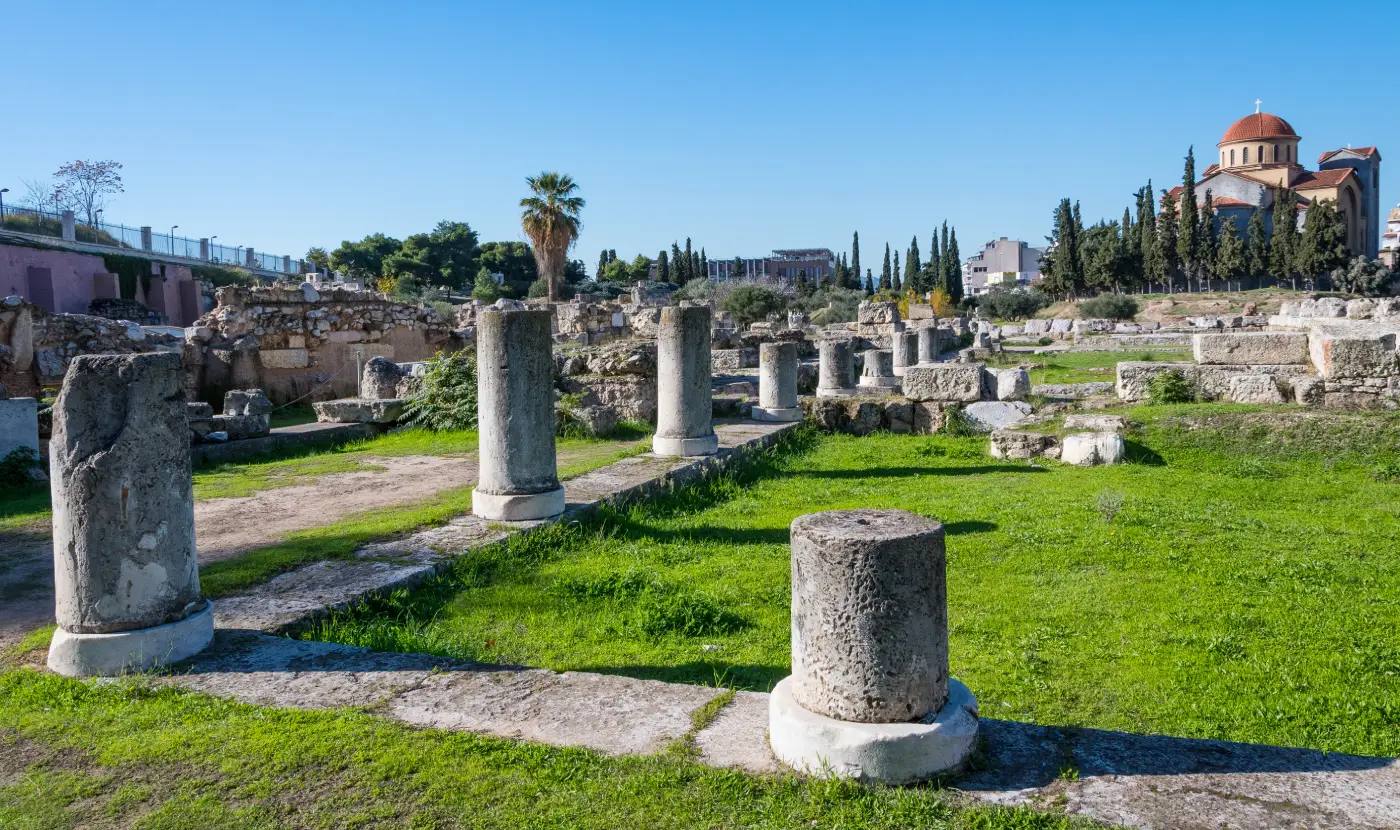
Kerameikos
Located at the end of Ermou Street, the Kerameikos Archaeological Site is one of the major archaeological sites in Athens. And though only a small portion of this ancient city quarter is open to the public, this site, home to the “Kerameis” (the potters) of antiquity, is a powerful and moving glimpse into the distant past. Also standing here are the ruins of the Dipylon Gate, the imposing double gates of the Themistocleian city wall, circa 478 B.C. numerous tombs with “replicated anaglyphs” occupy the site as well, the original anaglyphs being safely preserved in the Kerameikos Museum, also located here. The notorious Dimosio Sima, the public graveyard where ancient Athenians once buried their war heroes, is also part of this intriguing site. It is believed that Kerameikos took its name from one of two sources: the ancient kerameis, potters whose workshops occupied the area, or from the name of the Greek hero, Keramos. The imposing gates were first brought down by Syllas during his conquest of Athens in 86 B.C., and the final destruction took place during the Herulian sack of Athens in 267 A.C. thereafter, the area was used as a graveyard until the end of the Roman era in the 6th century.
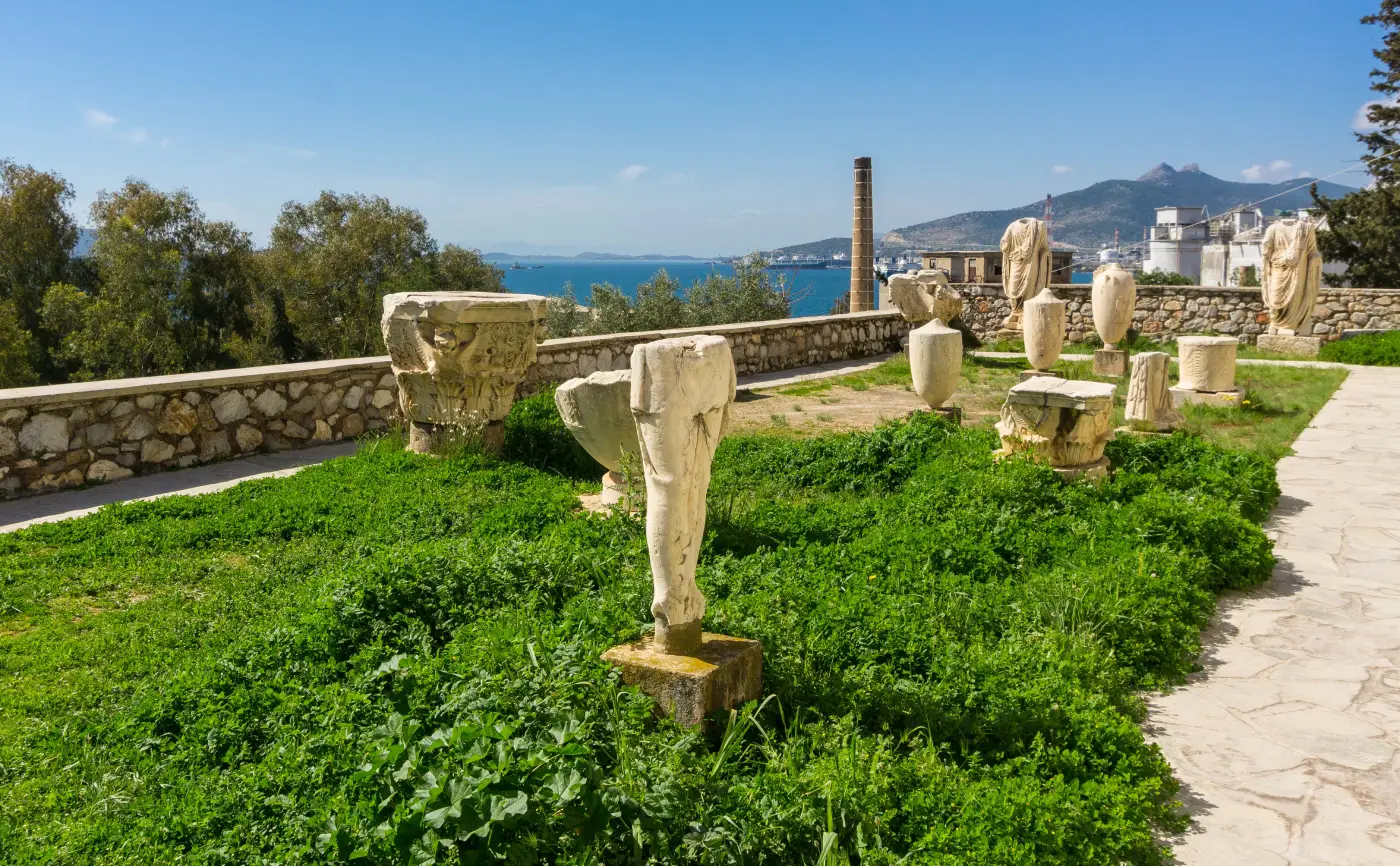
Archaeological Site of Eleusis
One of the most important archaeological sites in Greece, Eleusis, graphically displays the vast history of this residential area. Inhabited since the Middle Helladic era, it is renowned for the Eleusinian Mysteries, and Aeschylus, the greatest of the tragic poets. Since ancient Mycenae, the destiny of Eleusis has been linked to Athens. Several major monuments occupy this site, including the Sacred Yard, the ancient area of the gathering of believers, and the outmost destination of the Sacred Road; the Great Propylaea. Its Doric order entrance, a replication of the Mnesiklean Propylaea of the Acropolis in Athens; the Small Propylaea, displaying an Ionic order entrance; the Telesterion, site of the Palace and worship of adytum; the Triumphant Arches, Roman copies of the Arch of Hadrian in Athens; the Kallichoron Well, where, according to myth, Demeter sat during her quest for Persephone; the Ploutonion, a sacred cave with an entrance to Hades; and the Mycenaean manor, a rectangular Mycenaean temple.
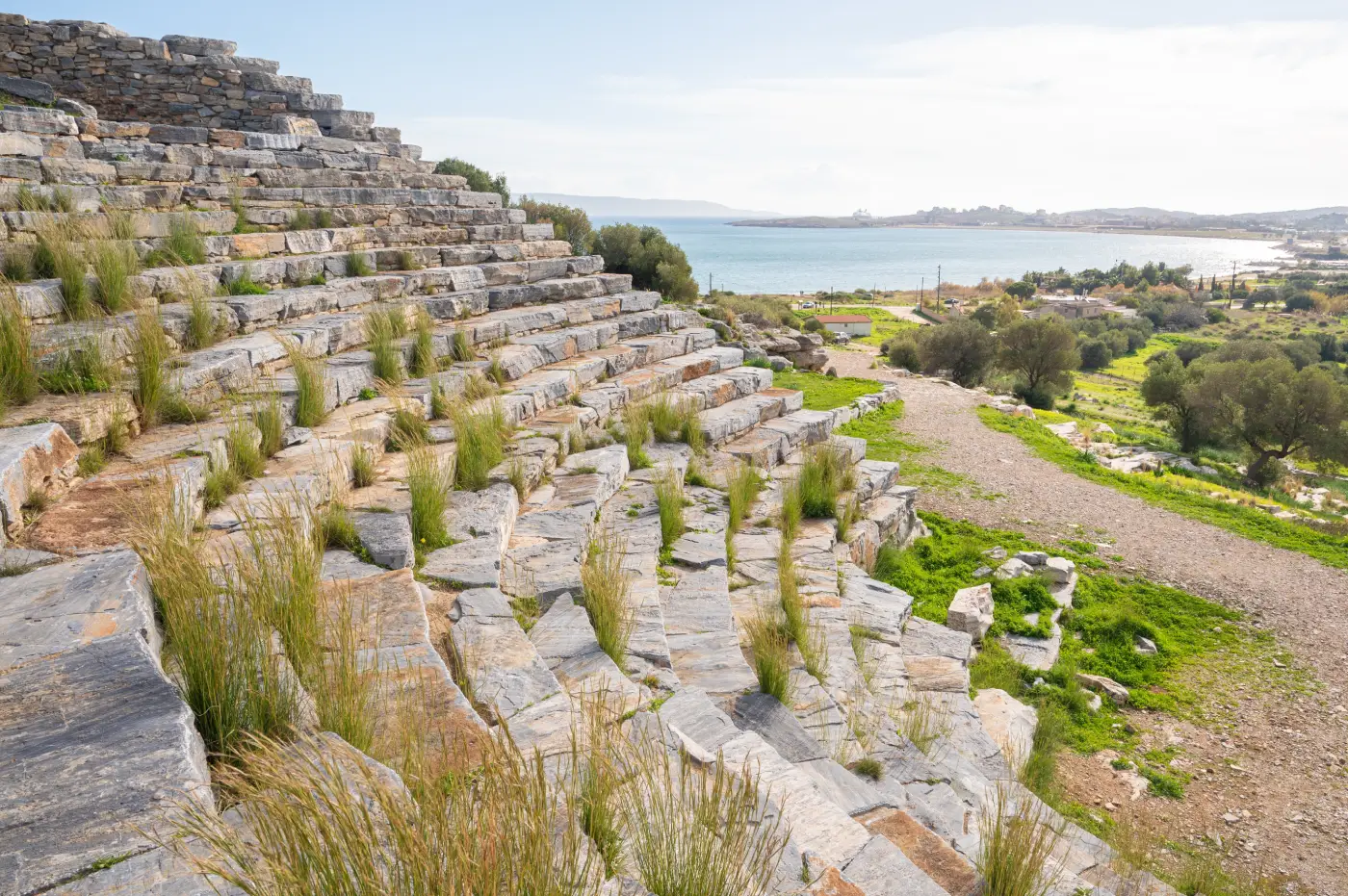
The Theatre at Thorikos
The theatre at Thorikos is the oldest known theatre in existence. Located north of Lavrion, almost adjacent to the city, it dates to the end of the Archaic Era, between 525 and 480 B.C. but that is not its only distinction. Unlike Greek theatres built in later eras, it is elliptical rather than circular and has a rectangular, rather than circular orchestra. With 21 rows of seats, the theatre had a seating capacity of 4,000 people. On the east side of the orchestra, sculpted out of the natural rock, is the base of the ancient temple, and a room, complete with benches, also sculpted from the rock. Dating from the mid-5th century, the temple was used for meetings of the Demos’ authorities, and, like the small temple and room complex of Dionysus, it also served the theatre when it was in operation; It had a wooden scene, which, unlike later theatres, was never replaced with one made of stone. The area of the theatre was never intended solely for theatrical performances but was also used for meetings of the citizens of Thorikos.
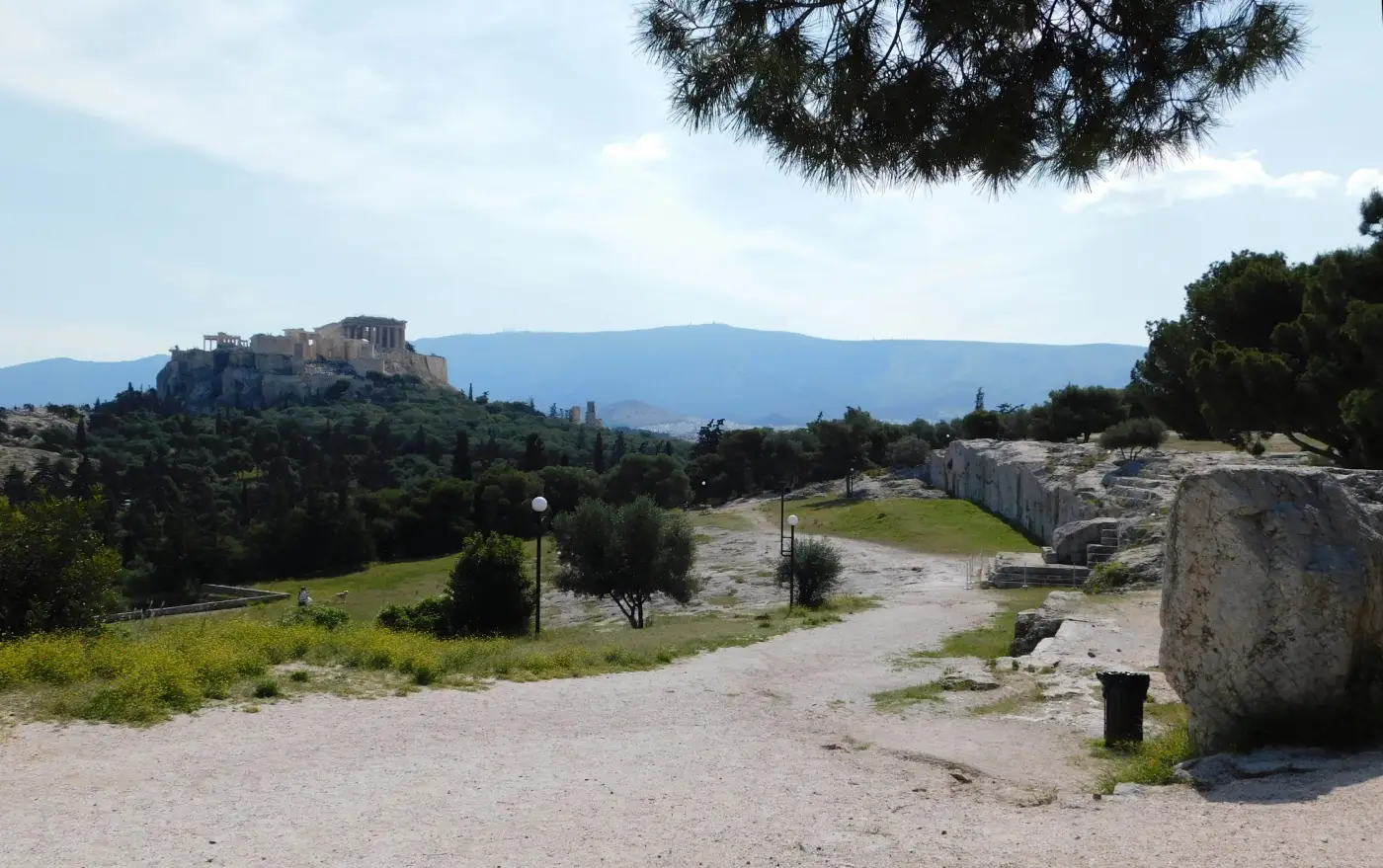
The Pnyx
At the western side of the Acropolis, located between Mouseion-Philopappos Hill, and the observatory, Hill of the Nymphs, lies the rock of the Pnyx. Due to its unique morphology and size, it was selected as the “seat” of the Ecclesia, and the area of assembly for Athenian citizens. It is believed that official functions at the Pnyx began sometime in the 6th century, during the age of the Reforms of Cleisthenes (508 B.C.). The first archaeological findings here date from the 5th century B.C.
In The New Testament, the Acts of the Apostles mention Apostle Paul’s Homily to the Athenians on the Pnyx in 51 A.C., which introduced the Christian religion to the Greeks. Thereafter, Dionysius Areopagite, who became the first bishop of the city, converted to Christianity, as did Damaris, the first Athenian woman to do so. She was subsequently martyred for her faith.
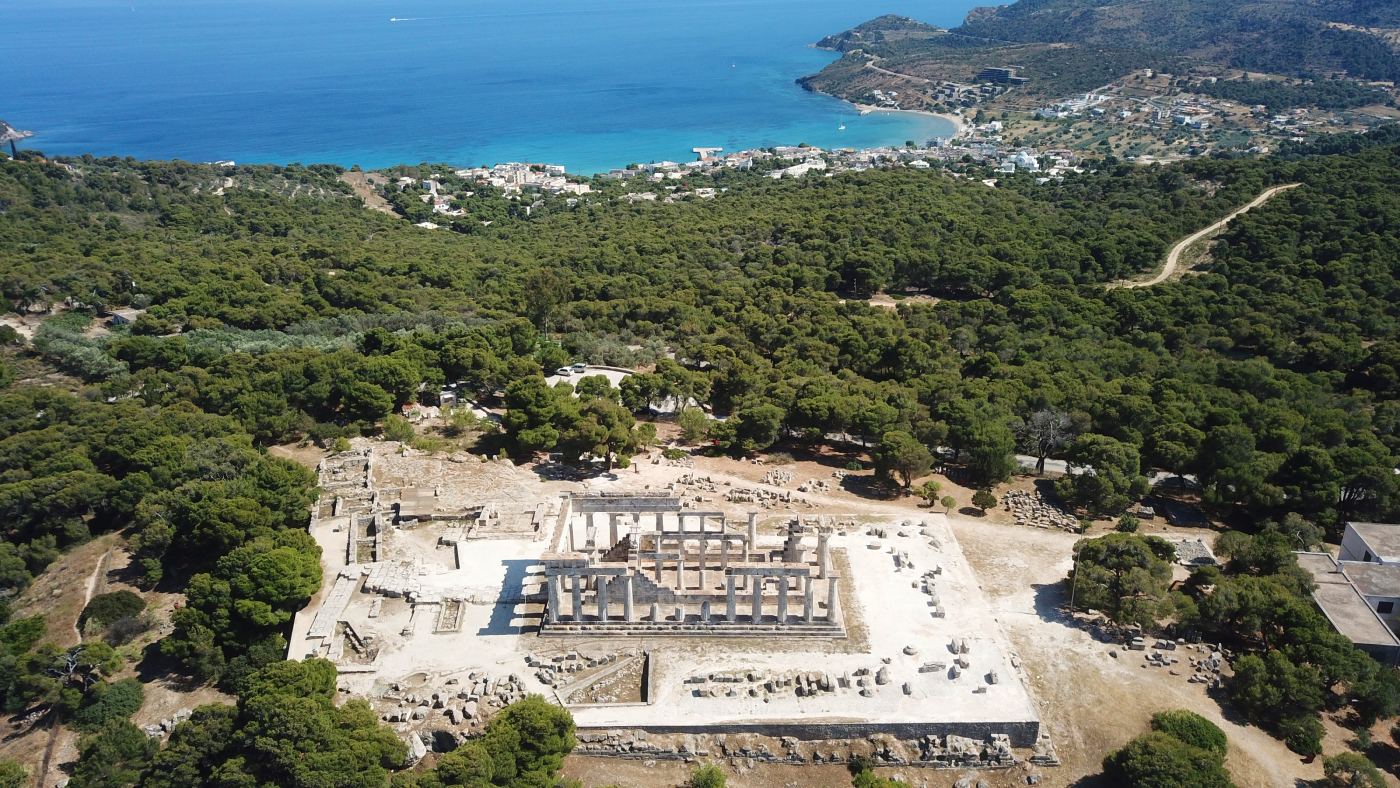
The Archaeological Site of the Temple of Athena Afaia
From its perch atop a pine-covered hill on the island of Aegina, the imposing temple of the Afaia watches over the sea. Built in the early 6th century to replace an earlier Doric temple, this well-preserved structure, located on the northeast side of the island, is dedicated to Afaia, a deity related to the Cretin goddess, Britomartis-Diktynna. The original, Doric-style structure was built from local limestone, with a double internal colonnade and a pitched roof with tiles made of Parian marble. Its gables are now on exhibit at the Munich Sculpture Gallery.
Made of marble, they depict themes from the Trojan War, featuring local heroes, like Telamon, son of Eakos. The western gable is archaic, dating from the late 6th century B.C., while the eastern gable features more recent, classical elements from the early 5th century B.C. Ancient tradition has it that the Temple of the Aphaia, along with the Acropolis and the Temple of Sounion, align to form a triangle.
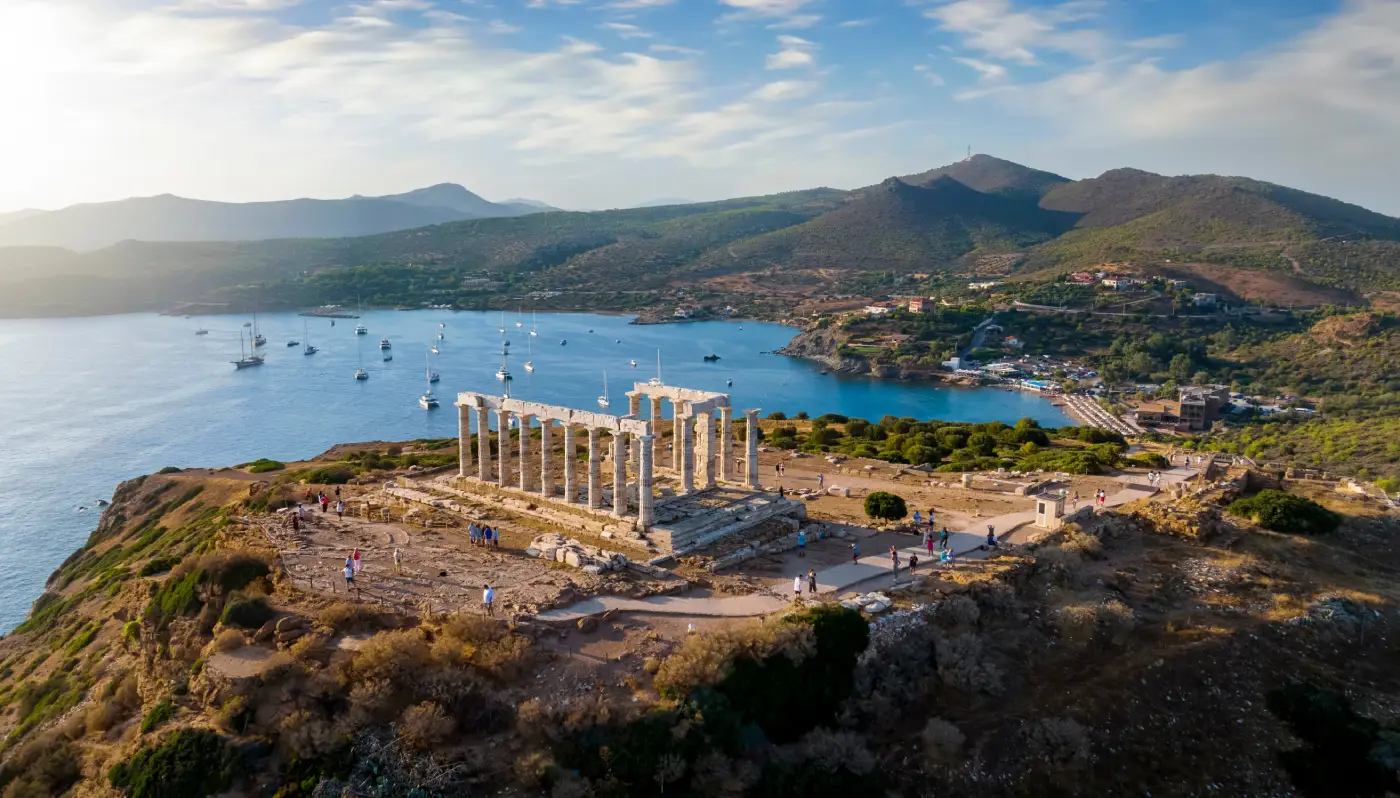
Sounion, the Temples of Poseidon and Athena
The majestic Temples of Poseidon and Athena stand on the rock of Cape Sounion, at the southern tip of the Attica peninsula, their sheer size and beauty cause admiration, whether viewed by sea or land. Used by the Athenians as a place of worship, as well as a fortress guarding the commercial seaways of the Aegean Sea, the Temple of Poseidon could be seen from afar by ships approaching the cape.
According to ancient Greek mythology, King Egeas committed suicide here, leaping to his death after seeing the ominous black sails of his ships returning home from Crete. Cape Sounion is one of the most photographed landscapes in Greece, and the view from the site is exquisite, day or night, but especially in the evening during a full moon. The monument attracts millions of Greek and foreign visitors.
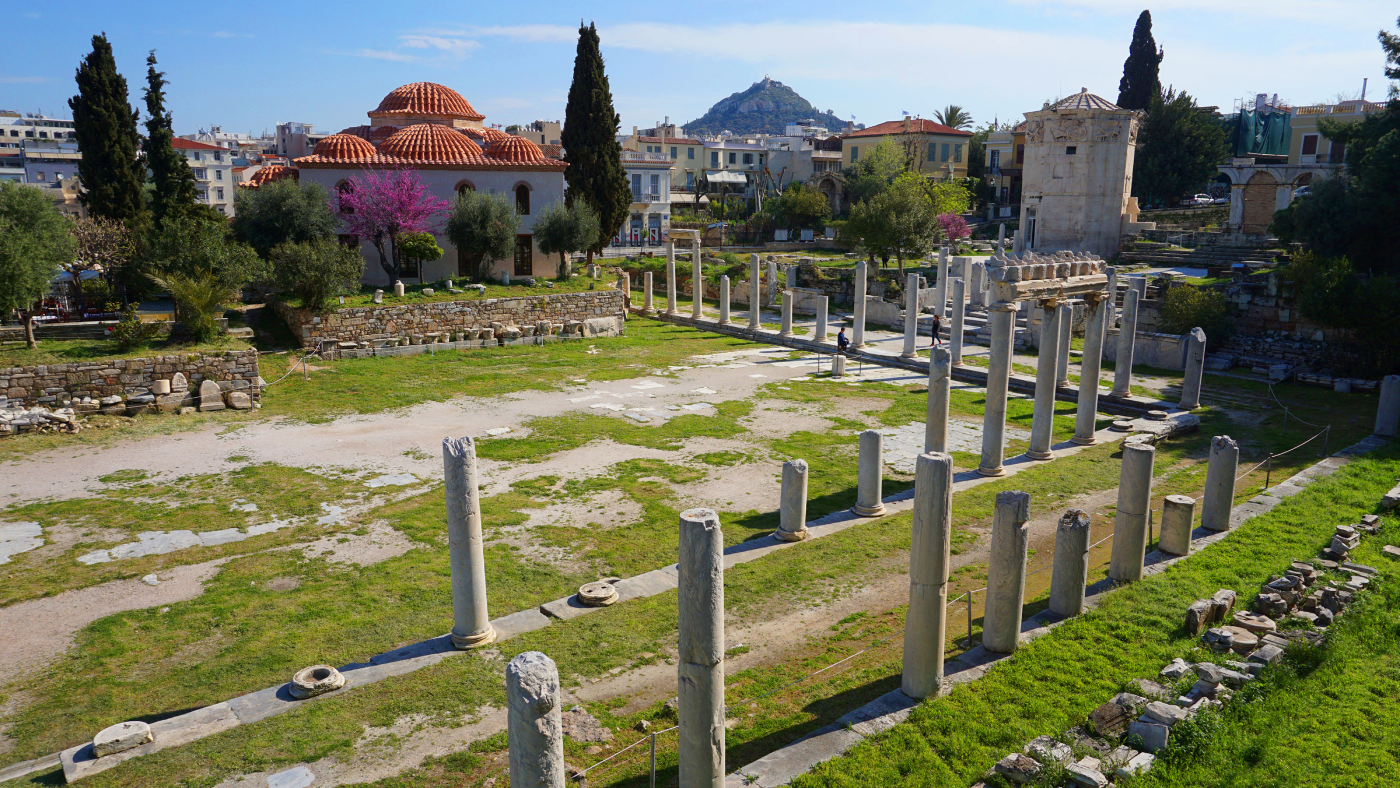
The Ancient Agora
Situated to the northwest of the Acropolis, the ancient Agora of Athens was originally established as the administrative and trade centre of the city, thus its name, the Agora, the “trade marketplace.” Deep in antiquity, the agora witnessed the procession of Panathinaia, the greatest celebration in the ancient city of Athens, one memorializing the unification of all of Attica under King Theseus. Inhabited since the pre-historic era, the Agora had become the city centre by the 6th century B.C. and was home to a plethora of secular and sacred social activities, practised in a multitude of public buildings, many of which still stand in ruins today.
Throughout its turbulent history, the Agora survived multiple sacks, suffering its most serious damage from the Persians in 480 B.C., the Romans under Syllas in 86 B.C., and the Heruli in 267 A.C. Finally abandoned in the 6th century, the area was dug under, eventually being covered over by houses and churches. The ruins of the ancient Agora remained buried and forgotten for fourteen hundred years until extensive excavations in the 19th and 20th centuries revealed its archaeological treasures.

Areopagus
The ancient Athenian Supreme Court once occupied this rocky hill just northwest of the Acropolis. Judging cases from murder and arson to sacrilege, the court even made decisions on new religious ideas. It is believed that this location got its name from one of two sources, the first being the murder trial of the god, Ares who, according to mythology, was tried on this very spot by Kekrops, King of Athens, for the murder of Allerothios, son of Poseidon. The second theory is that it came from the temple of the Areian Erinyes, the sinister deities of punishment, scruples, and revenge. Mythology also tells us that the Areopagus also convicted Orestes for the killing of his mother Clytemnestra, and was saved by the vote of goddess Athena. The Athenians then referred to the Erinyea as being humble and pacified.
From the Mycenaean era until the Geometrical years (1600-700 B.C.), the northern slope of the hill was used as a cemetery. Subsequently, during the late Roman era from the 4th to 6th century A.C., four mansions were built on the Areopagus, replaced in the 15th and 16th centuries by a church honoring Saint Dionysius Aeropagite, the first Christian bishop of Athens. All later buildings covering the remnants of the Classical years were removed during the Ottoman era.
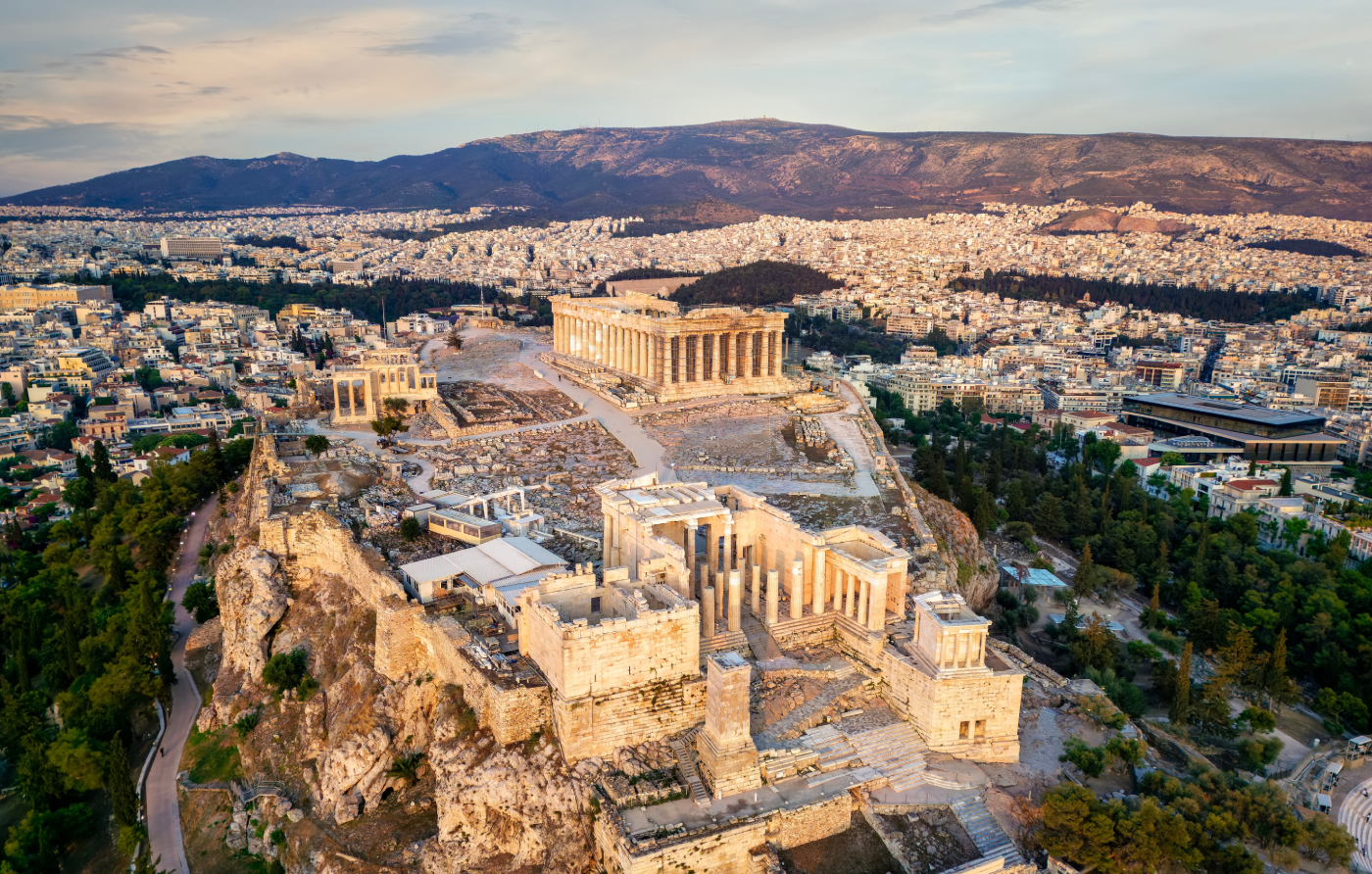
Acropolis
The world-famous Acropolis, the “sacred rock,” is a fortified hill towering 156 meters high in the heart of Athens, its summit is home to one of the most important historical building complexes ever constructed by man, awe-inspiring symbols of humankind’s quest for balance, reason, justice and democracy, ageless reminders that this is the birthplace of western civilization. It also reminds us that the Greek Civilization has thrived here since the prehistoric era. Used regularly by the ancient Athenians since the 3rd millennium B.C., traces have been uncovered here, dating as far back as the Mycenaean era, as well as traces of archaic-era temples. Today, visitors can admire amazing 5th-century architecture like the Parthenon, the Erechteion, the Propylaea, and the Temple of Nike Apteros.
The Acropolis was used during later years for religious, administrative, and even defensive purposes. In fact, the monuments suffered substantial damage due to war; in 1687 the Acropolis was bombed by Morozzini, and Kioutahi Pasha’s siege of 1826 to 1827 did further damage. But these interventions from foreign conquerors and religious fanatics did not diminish, in the least, the stunning beauty or cultural significance of these monuments. The Parthenon, a monument of Global Heritage (UNESCO 1987), is today the most visited sight in Greece, attracting millions of visitors each year.
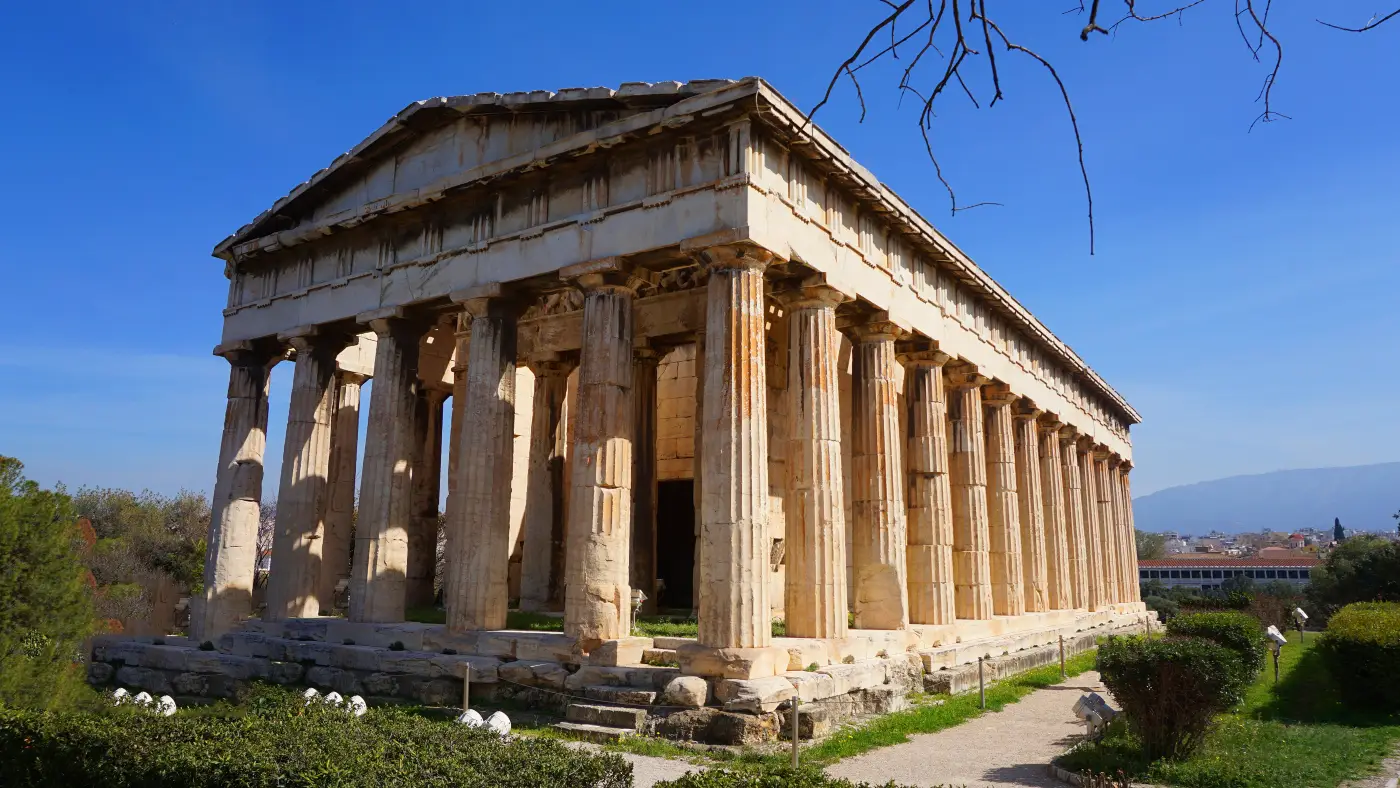
The Theseum, Temple of Hephaestus
The Temple of Hephaestus at the Ancient Agora is the best preserved and restored ancient temple in Athens. Built during the Golden Age of Athens in 450 B.C., it is believed to have been constructed, either by Iktinos or, possibly by someone else, whose name was lost to antiquity. But based on similarities in design, it has been surmised that the architect who built the Temple of Hephaestus, more than likely designed the identical temples of Poseidon in Sounion, Nemessis in Ramnous, and Ares in Menidi. It is interesting to note that this temple was initially dedicated to the hero, Theseus, who also named the area we now call Athens.
When Christianity prevailed, the Doric temple of Hephaestus was converted into a church in honour of Saint George. During the Ottoman occupation, the Athenians kept the church closed to avoid its conversion into a mosque by the Ottomans. Opening its doors only when celebrating their Saint’s name day, the Athenians called this church “Saint George Akamatis” (Lazy), to point out this peculiarity.

Academia Platonos
Academia Platonos is an Athenian neighbourhood that has experienced intense industrial and residential development. Its name derives from two sources, the most recognizable being the famous Athenian philosopher, Plato, the second being a local Greek hero by the name of Akademos. Founded by Plato in 387 B.C., the Academy thrived during the years of the Neo-Platonic philosophers, until being permanently closed in 529 B.C., by Emperor Justinian, who shut down all other Athenian schools as well. Inhabited since the early pre-historic era, this area began undergoing major changes with the arrival of Tyrant Hippias in the 6th century B.C. A gymnasium was built on the site, and Hippias built a peribolo; nearly a century later, Cimon planted the entire area with trees, but in 86 B.C. they were chopped down when Syllas sacked Athens.
Excavations over the last eighty-three years have revealed some truly significant findings here, such as an arched residence from the Early Helladic era, thought to be the actual home of the mythical hero, Akademos; a sacred house from the Geometric era; a peristyle building from the 4th century B.C.; the Roman gymnasium dating to the 1st century A.C., and multiple other buildings.

Monument of Lysicrates
Located near the Acropolis on Tripodon Street, the Choragic Monument of Lysicrates was erected by the choregos Lysicrates, a wealthy patron of musical performances at the Theater of Dionysus. According to the inscription carved on the monument’s epistyle, Lysicrates built the monument to commemorate the award of first prize in 335/334 B.C. Circular in design, and anchored on a square podium of limestone, the centrepiece is surrounded by six elaborate, Corinthian-style columns made of white Pentelic marble. Its frieze sculptures depict episodes from the myth of Dionysus, and it is crowned by a monolithic roof that supports the choragic tripod.
This ancient monument, also called the “Lantern of Diogenes”, by contemporary Athenians, was arbitrarily enclosed by the nearby French Catholic Capuchin monastery during the 17th century, being used as a reading chamber and for storing books. In 1821, the convent was destroyed during the battles for independence. But the monument survived and is considered by many to be the best-preserved sample of an ancient choragic monument in existence. It now occupies the centre of Lysicratous Square, evoking admiration from passers-by.

The Theatre of Dionysus
In the Classical Era, the Theatre of Dionysus was where Attican drama was taught during the celebration of the Great Dionyssia, one of the major religious festivals of the city. The theatre formed a substantial part of the temple of Dionysus Elephtherios, located below the rock of the Acropolis. Believed to have been built during the rule of the descendants of the tyrant Peisistratus, it underwent so many subsequent alterations and expansions, that it became impossible to follow its precise architectural evolution.
Today’s remnants derive from the late Roman phase of the Theatre, with only a few rows of benches remaining from its Classical phase. Currently, an effort is underway to restore the ancient theatre, using the original Corinthian stone fragments that are scattered over the site.

Stoa of Attalos
The impressive Stoa of Attalos is the restored building located on the eastern side of the Ancient Agora. Now protected as part of the archaeological site, the stoa was named after King Attalus II of Pergamon, who gave it to the city as a gift. Erected for twenty-one years, between 159 and 138 B.C., the Stoa was, at the time, the longest free-standing, roofed building in the city.
Built to house the city’s commercial activities, the two-story structure was 120 meters long, with 21 stores and workshops. With walls constructed entirely of limestone, the doorjambs, doors, staircases, columns and wall studs were all made of white Pentelic marble. Destroyed during the Herulian sack of Athens in 267 A.C., the Stoa’s remnants were later used to build the Late Roman fortification wall.
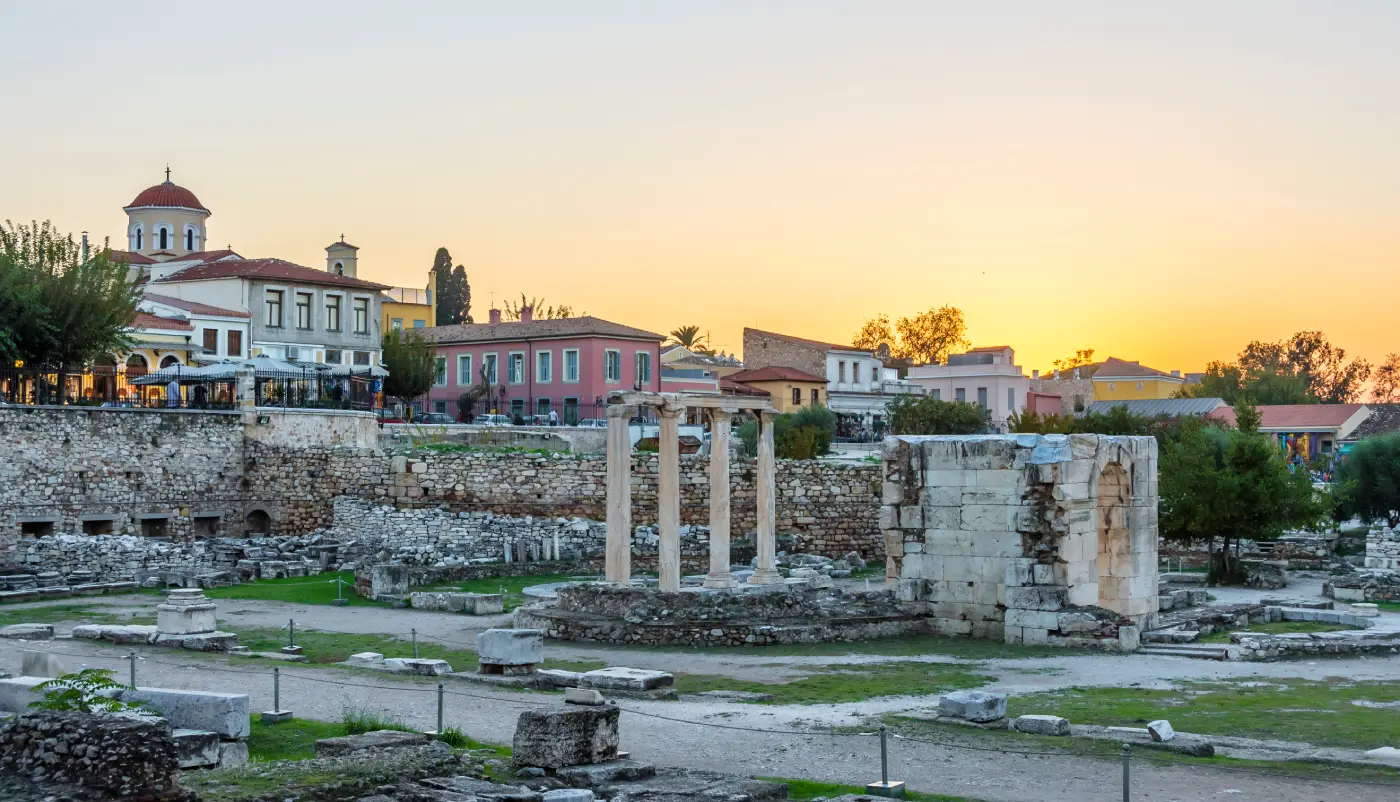
The Roman Forum
Situated in the historic Athenian neighbourhoods of Plaka and Monastiraki, the Roman Forum was built during the rule of the Roman Emperor Augustus, between 19 and 11 B.C. to house the city’s trade centre. Later, under the rule of Emperor Hadrian, the Forum was restructured and expanded, with its main yard being paved. Major landmarks in the area include the Horologion, built by Andronicus of Cyrrhus (also known as “Tower of the Winds”), and the Forum’s western gate, which has been well preserved.
The most significant feature distinguishing the Forum from the classic agora is that the Forum was built primarily for trade. After the city’s destruction during the Herulian invasion in the late 3rd century A.C., trade activities were conducted within the confines of the Forum, its Roman walls offering protection. Eventually, this location evolved into the administrative centre of Athens. But nothing is ever permanent, and over the centuries, the Byzantine era, followed by the Frankish and Ottoman occupations again changed the Forum; Christian churches, new houses and workshops rose, followed later by the Fetihie mosque, all built at the site. But trade activities, such as the wheat market, were preserved.
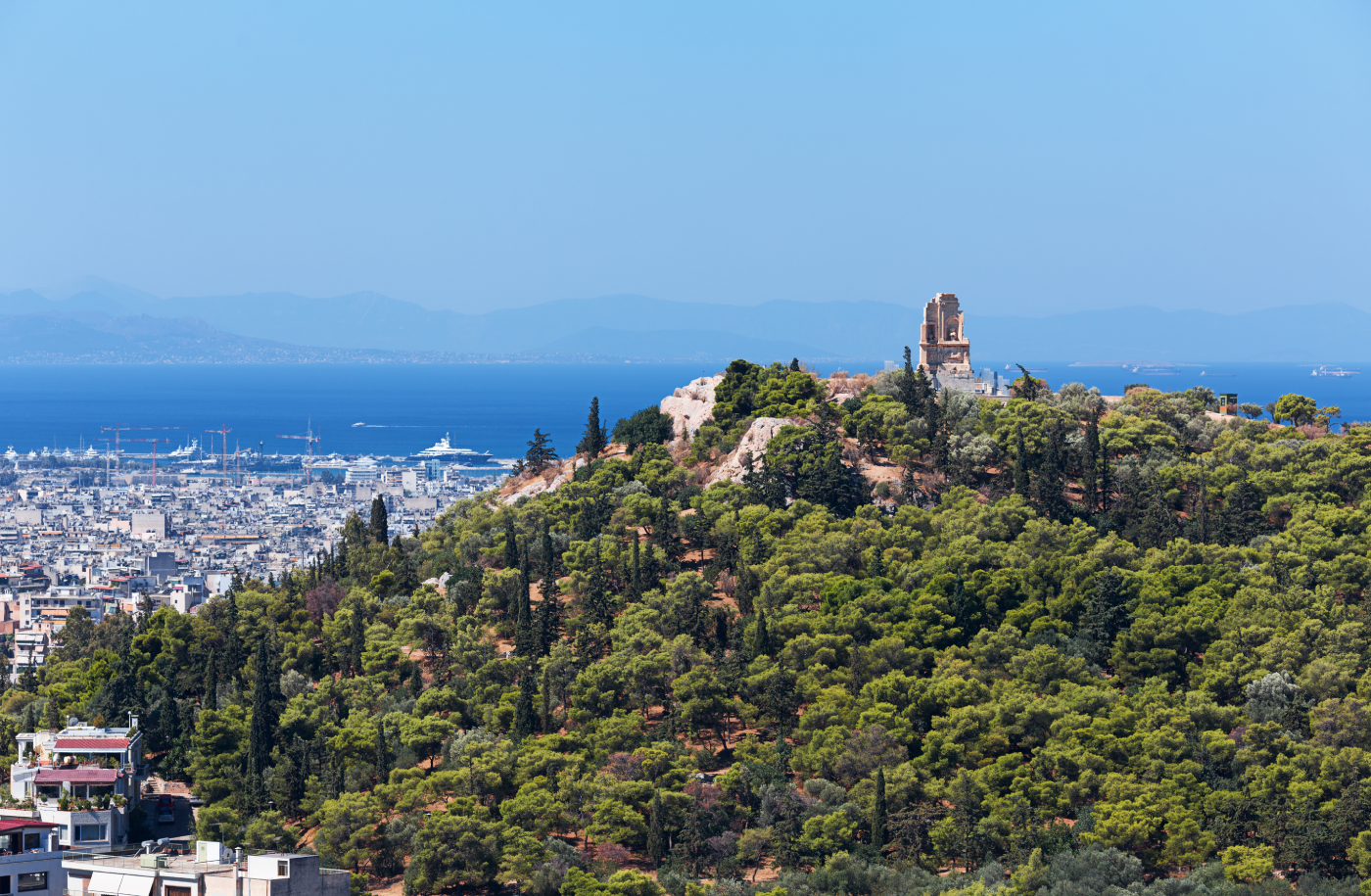
The Hill and the Monument of Philopappos
Philopappos Hill, or “Mousseion Hill” as it was known in antiquity, is situated northwest of the Acropolis rock. Named after Philopappos, grandson of Antiochus IV Epiphanes, King of Syria, the hill was honoured with the title of this Roman consul, who was a great lover of the city. Declared an Athenian citizen in the late 1st century, Philopappos was bestowed with various offices.
During excavations by archaeologist Konstantinos Travlos, he uncovered an ancient monument that turned out to be the actual mausoleum of Philopappos. Only one wall of the Mausoleum remains today, showing relief scenes from Philopappos’ life. An inscription was also saved. Due to its numerous decorative elements, it is believed that this monument is one of lesser import than others of Classical and Hellenistic Athens.
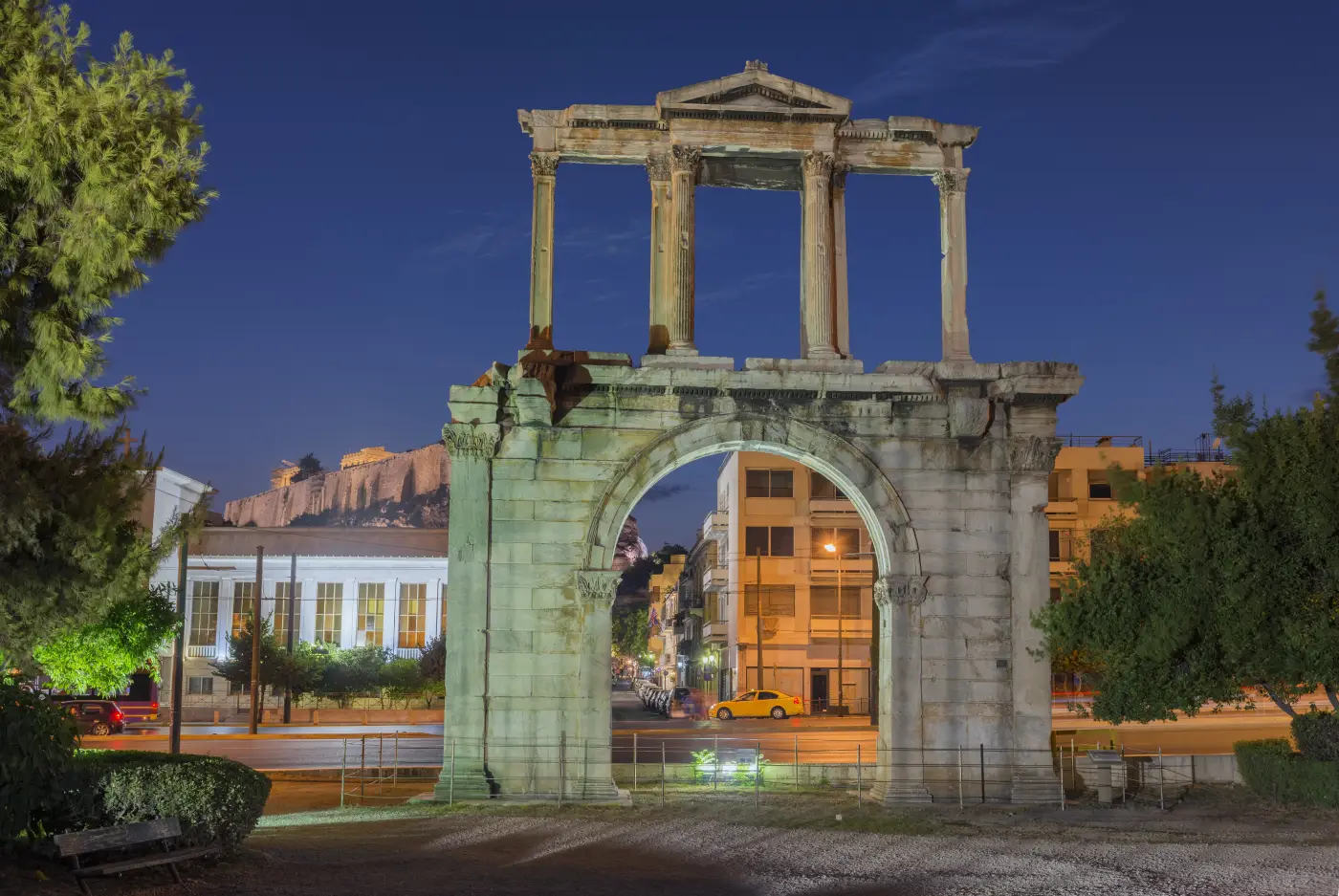
The Gate of Hadrian
Philhellene Roman Emperor, Hadrian (117-138 μ.Χ.), founded a new neighbourhood near the eastern border of ancient Athens. To honour him, the Athenians named it Adrianopolis, and in 131-132 A.C., built an arch of Pentelic marble, leading from the old city into the new. Situated near the Temple of Olympian Zeus, the arch remains intact and in excellent condition, and is one of the most recognizable, and photographed landmarks of the city.
In the late 18th century, the arch served as part of the city’s defensive wall, known at the time as the Haseki Wall. It was later named the “Gate of the Princess” or the “Arch Gate.” Today it stands in the very heart of modern Athens, a stunning marble monument to the days of glory in ancient Athens.
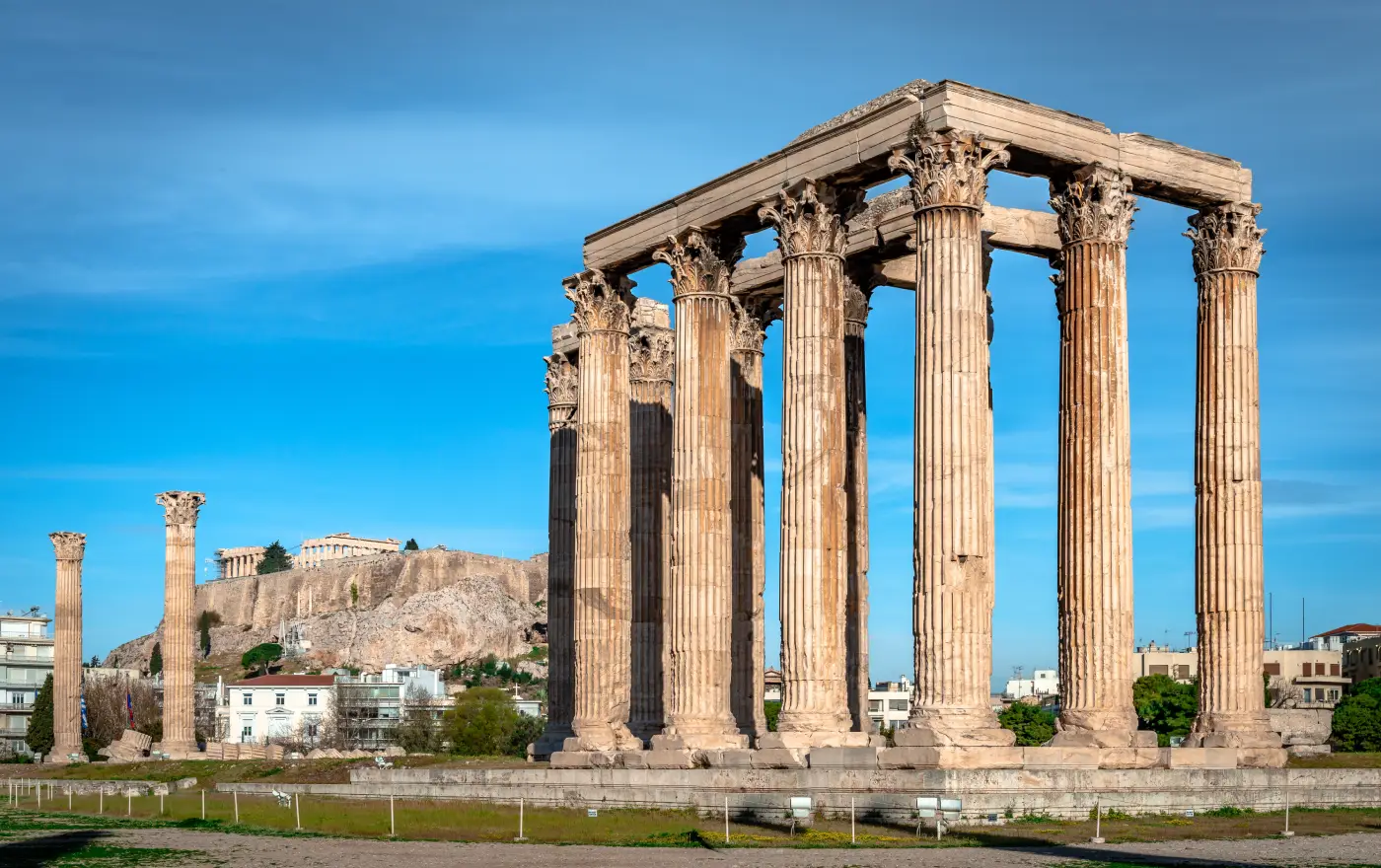
The Columns of Olympian Zeus, Olympieion
Visible to the southwest of the Acropolis, is the Temple of Olympian Zeus. Construction began in the 6th century B.C., during the rule of the tyrant of Athens, Peisistratus. However, construction was halted throughout the era of Athenian Democracy, as the temple was deemed a symbol of tyranny. Later, during the Hellenistic period, there was an attempt to resume construction, by Antiochus IV Epiphanes, King of Syria, but work was once again terminated when he died. Still only half-finished, serious damage was inflicted on the Temple by Lucius Cornelius Sulla, who sacked Athens in 86 B.C.
It was not until the accession of the Philhellene Emperor, Hadrian, in 131 A.C. that the project was finally completed, following its original design. The Temple was abandoned and badly damaged again, during the Herulian sack of Athens in the 3rd century, when most of the columns were torn down, to be used as building materials. Sixteen columns remain today, fifteen of them still standing and one lying on the ground, where it fell during a storm in 1852. Apart from the main temple, the site also contains remnants from Roman thermae, Classical Era residences, foundations of an Early Christian basilica, and parts of the city’s Roman fortifications
.
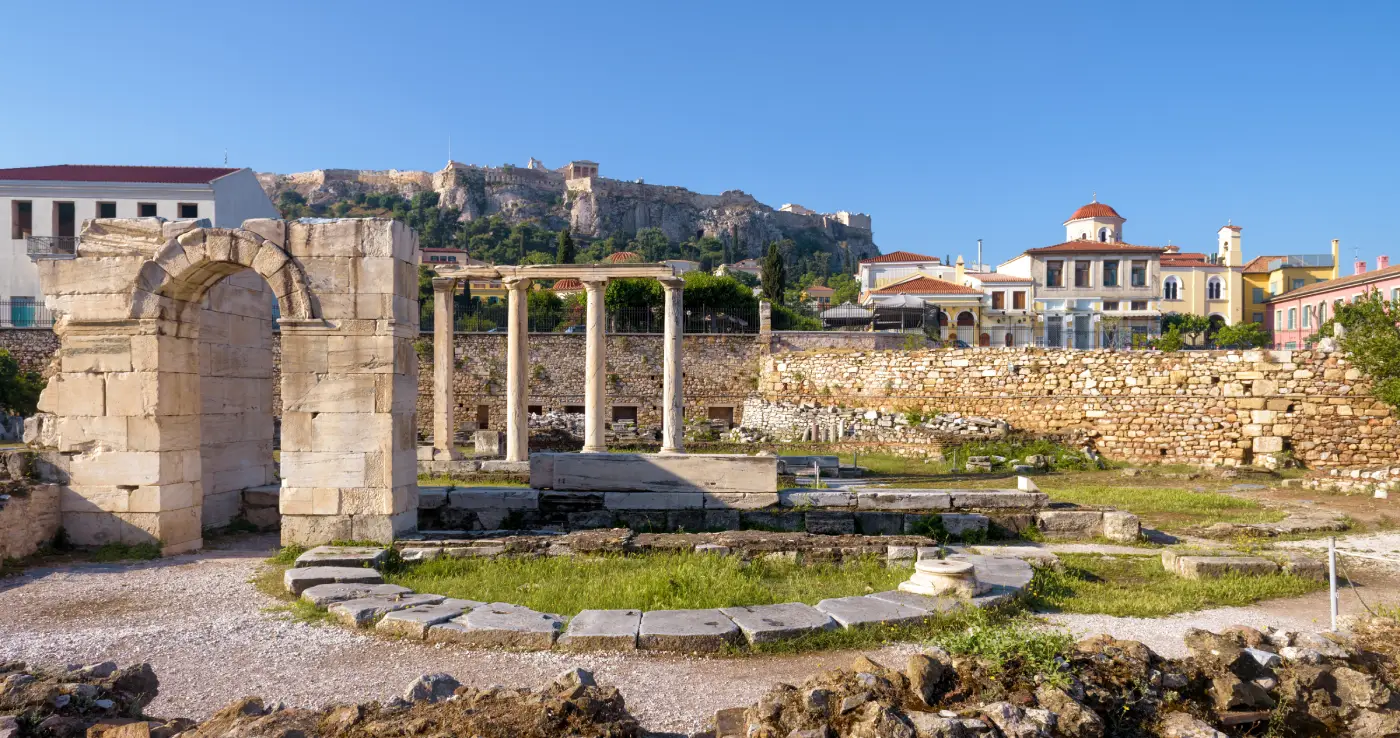
Hadrian's Library
On Areos Street, just opposite the entrance to the Monastiraki metro station, lies the archaeological site of Hadrian’s Library. Though only a few remnants remain intact, many other valuable findings are being unearthed in this ongoing excavation. Described in written detail by Pausanias the traveller in the 2nd century A.C., the Library was comprised of 100 columns, supporting a gilded roof, and was decorated with precious alabaster artefacts.
Today the visitor can see the pediments of the internal yard columns, the four, seven-meter-long forming alleys, the foundations, some two-story walls near the southern perimeter, remnants of a pavilion in the centre of the yard, and, to the north-west, the Library entrance, framed by seven Corinthian era columns. The entrance to the site is on Areos Street, opposite the exit of the Monastiraki Metro station.

Herod Atticus Odeon, or the Irodeion
The Herod Atticus Odeon, or the Irodeion as it is called today, was built on the southwestern slope of the rock of the Acropolis during the Roman era, by the Athenian magnate Herod Atticus, in memory of his wife Regilla. Following the city’s decline during the Byzantine era, the Odeon became derelict and was buried under tons of dirt. During the subsequent Ottoman occupation, foreign visitors to the site gave the scant remnants many different names, most of them made up. It seemed as if the Irodeion would simply fade from memory.
That is, until 1764, when British archaeologist, Chandler, reawakened interest in Herod Atticus Odeon. Then, in the 19th century, excavations unearthed the ruins of the ancient theatre. Completely refurbished by the 1950s, the seats were now covered with Pentelic marble, and the orchestra with marble from Mt Hymettus. Since then, the theatre has been used for high-level cultural productions during the summer season, mainly the Athens Festival.
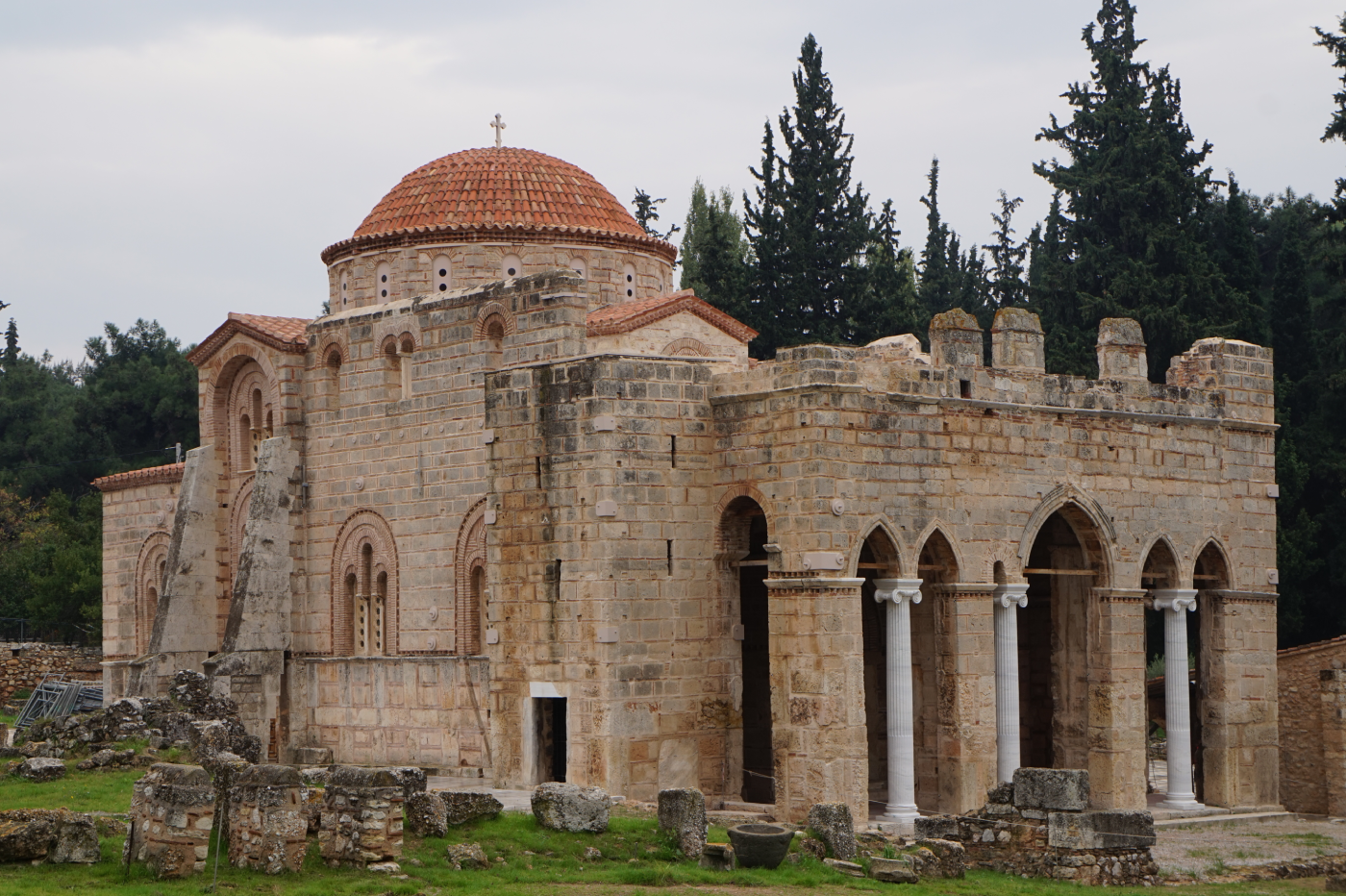
The Dafni Monastery
Situated at the edge of the Haidari parkland, the Dafni Monastery is said to have been built at the site of the ancient temple of Apollo Dafnaios. Fortified and surrounded by high defensive walls, only two entrances lead to the perivolos, where the Monastery’s main church is located, the imposing “Katholikon.” Other structures, including the monks’ chambers and the dining room, are also located here. Like most of Athens’ Byzantine buildings, the monastery’s Katholikon dates from the 11th century, and has been restored multiple times during its thousand years of existence. Fortunately, many of its exquisite, original mosaic decorations have been preserved.
Over the centuries, the Monastery gradually fell into disrepair and, by the late 19th century, it had been abandoned by the monks, subsequently being used as a public mental hospital. Today, however, this fortified monastery is included in the UNESCO World Record of Cultural Heritage.
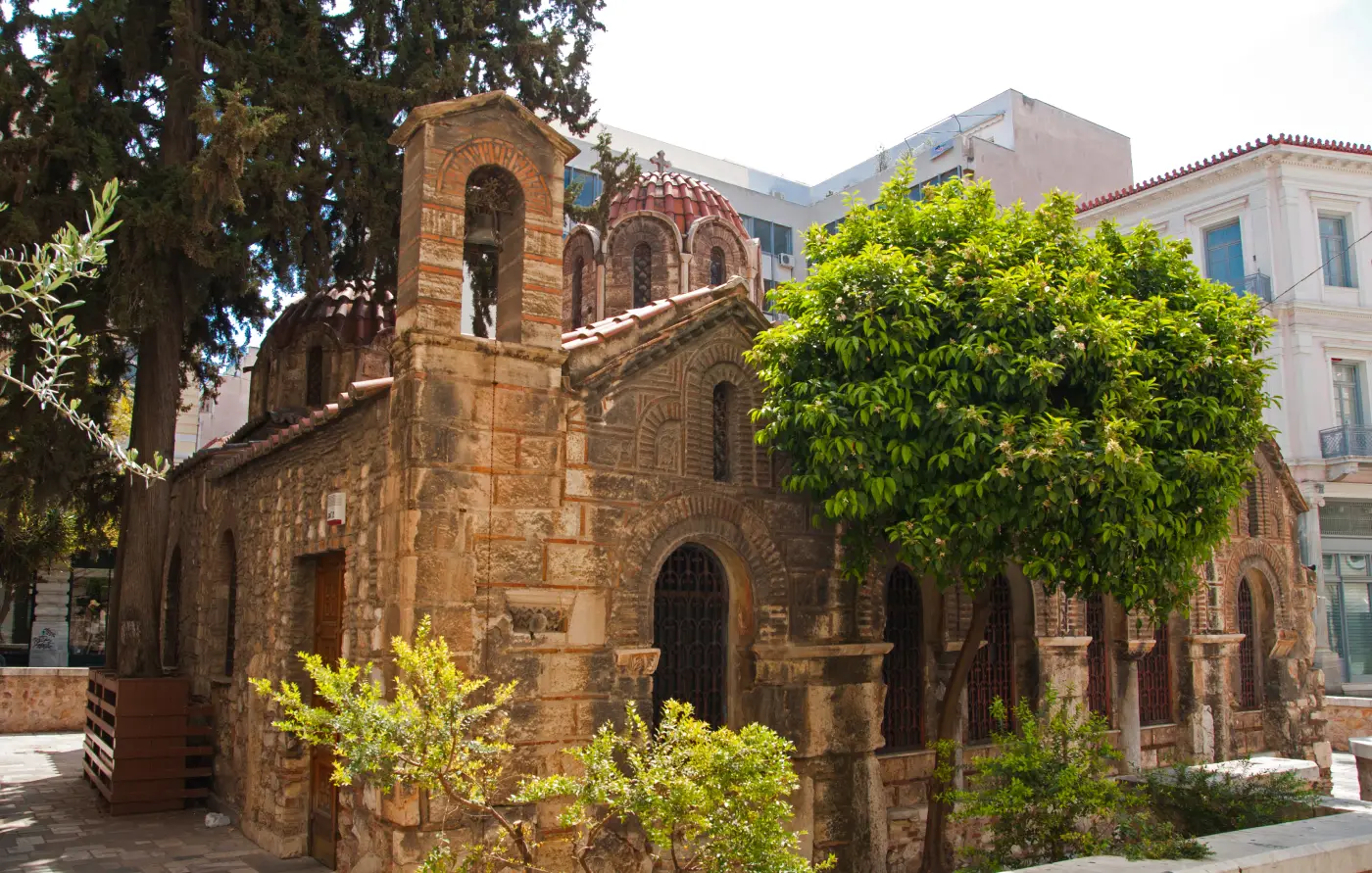
Kapnikarea
The Byzantine church of Kapnikarea is one of the major landmarks of Athens’ Byzantine past. Dating from the 11th century, it is dedicated to the “Presentation of the Virgin to the Temple,” and lies in the middle of Ermou Street. It is believed that the church was built over an older, Christian temple, commissioned in the 5th century A.C. by the Athenian Empress of Byzantine, Eudokia, wife of Emperor Theodosius the Younger. Constructed atop the foundations of the ancient temple of Athena or, perhaps, Demeter, it is today owned by the University of Athens.
Constructed as a domed, cross-in-square complex, the three sections of the church were built at separate times; In the early 20th century, the chapel of St. Barbara was added to the northern section of the church. Many of the interior murals were painted by famed artist, Fotis Kondoglou. The temple owes its name to its first owner who, according to tradition, collected the “Tobacco Tax” (kapnikos foros) in the city. Yet another tradition is connected to the church’s older name, “Kamouharea”, the famous silk cloth workshops (kamouhades) that operated in the area.

Church of Agios Nikolaos Ragavas
The church of Agios Nikolaos Ragavas is located in Plaka, close to the Anafiotika neighbourhood. Built in the 11th century, it is one of the major monuments from that era. Based on the simple four-aisled, cross-in-square design, the church is topped with a small octagonal dome of the Athenian era. Originally belonging to a Byzantine family named Ragavis, the church became derelict during the Revolution of 1821 but was eventually rebuilt using the original materials.
Since then, it has undergone numerous modifications, which have significantly altered its appearance. During the 1970’s it was partially restored to its original condition, but not completely. Tradition has it that this church’s bell was the first one to ring out following the liberation of Athens from German occupation on October 12, 1944.
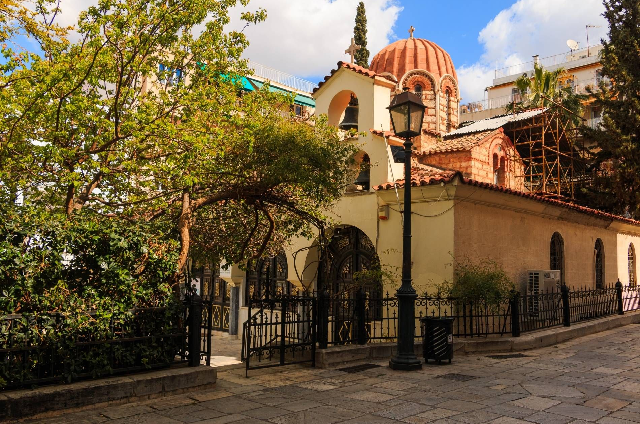
The Church of Ag. Aikaterini
Located in Plaka, the Church of Ag. Aikaterini was built in the middle of the 11th century and is a domed, cross-in-square, four-aisled complex. Experts of Byzantine history believe the church was dedicated to Ag. Theodoros, as indicated by the inscription on the marble column supporting the Altar.
This is the old parish church of the Alikokos neighbourhood in Plaka, just opposite the choragic monument of Lysicrates, which, in later years was enclosed by the old Catholic Capuchin monastery. Its interior murals were painted in the late 19th century by hagiographer, G.D. Kafetzidakis.

The Benizelos family Mansion
The mansion of the Benizelos family, the famous Athenian family during Ottoman rule, was built in the 16th century, during the early years of Ottoman rule, before the destruction caused by Morozini. A notable member of the renowned family was Riggoula Benizelou, later canonized as Saint Philothei. On the ground floor of the imposing building, a colonnade is created with a sufficient number of beautiful cylindrical columns with simple arches.
Additionally, the stone staircase on the facade is discernible, leading from the enclosed courtyard of the mansion to the first floor, the upper floor. There is a balcony with large openings supported by columns. In later years, the large openings were covered with sliding glass. The enclosed courtyard is surrounded by tall stone walls, like all Athenian houses of that era. It is perhaps the most significant architectural and historical building of the Ottoman period, which has not yet received the attention it deserves.

The Metochion (embassy church) of the Holy Sepulchre
The 17th-century Church of Agioi Anargyroi, also known as the Metochion of the Holy Sepulchre, is located at Anafiotika, in Plaka. Originally opened as a convent, it is presumed to have been owned by the prominent Kolokinthi family. The church is a single-clite basilica, dedicated to the Ag. Anargyroi.
Due to its function as an embassy church of the Holy Sepulchre since the 18th century, the Metochion is deeply involved with the holy ceremonies of Easter. Designated as the point of initial reception of the Holy Light from the Sepulchre in Jerusalem, on the night of the celebration of the Holy Resurrection, the church attracts many visitors. It was built on the site of an ancient temple dedicated to goddess Aphrodite.
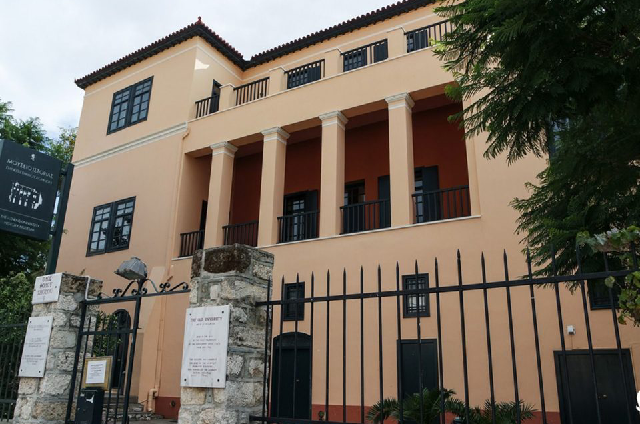
Kleanthi Residence
Kleanthi-Schaubert, or the “Old University” is on Tholou Street in one of the higher sections of Plaka. Built around the 17th century, the institution was purchased from its Ottoman owner by two close friends, architects Kleanthis and Schaubert, who, after arriving in the newly liberated Athens, went to work on the old building, repairing and restoring its huge walls and domed basements, adding other buildings, and uniting them all into a single complex. In 1834 the building housed the Girls High School and, later, the newly founded University. Then, in 1837, three new rooms and an Anatomy auditorium were added to cover the needs of the new University. When the University finally moved into its building after 1841, the original Kleanthi Residence became the Didaskaleion and the Experimental InterTeaching School, which was later used as a barracks. The facility changed hands many times over the years and was used for various purposes until 1963 when it was declared a listed building. In 1967 it was officially assigned to the University. Since then, it has been restored, and now houses the University’s History Museum.
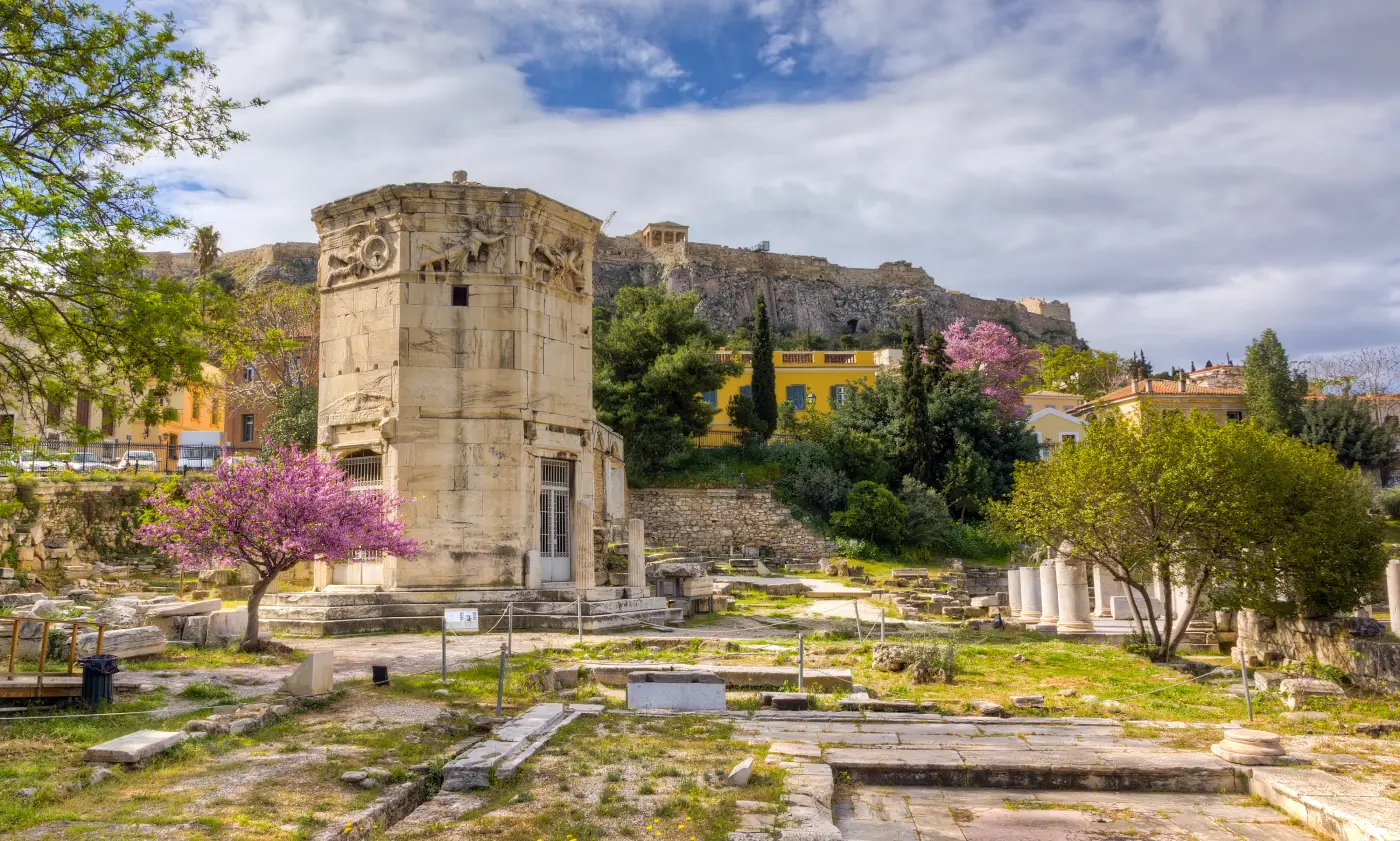
The Baths of the Aerides
The Turkish Bath of the Aerides is located on Kyrristou Street in Plaka. Built during the years of the Ottoman occupation, the “Ibn Efendi Turkish Bath” was open to the public. Extensively damaged during the siege of the Acropolis by Kioutahi Pasha in 1827, it was later repaired and modernized by King Otto. Following World War II, the bath continued operations until 1960, when it was abandoned.
During the 1980s and the 1990s, the Ministry of Civilization performed several interventions and restructuring work, to restore the building and turn it into an exhibition venue. Today, visitors can see how a Turkish bath operated during the time of the Ottoman occupation, as well as in subsequent eras. The building also houses an annexe of the Museum of Hellenic Folk Art.
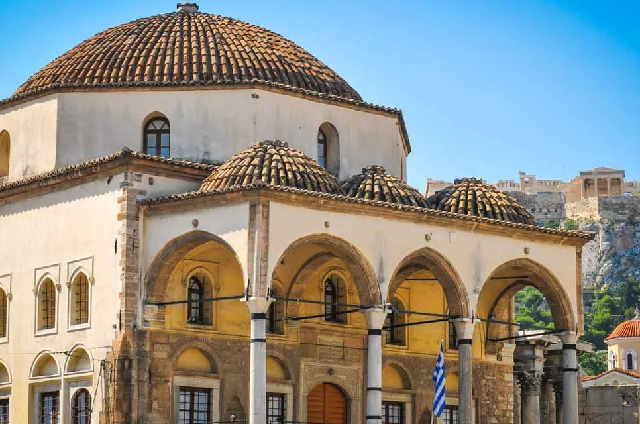
The Tzistarakis Mosque
Known as the “Tzistarakis Mosque,” this is one of the few Muslim monuments remaining in Athens. Built in 1759 by Governor Tzistarakis, during the second period (1689-1821) of the Ottoman occupation, it has been rumoured that the lime used for its construction was procured by melting down a column from the Olympieion. However, research has proved that a column from Hadrian’s Library was actually used. In the 20th century, the mosque housed the Museum of Hellenic Folk Art.
Today it serves as an annex of this museum. It is remarkable that in 1966, the mosque was partially restored so that Ibn Saud, exiled, ex-monarch of Saudi Arabia, could perform his religious duties there.

Hydra Traditional Residential Area
The picturesque town of Hydra, the capital and port of the island, has been declared a “preserved historical site.” Located in the centre of the island, its magnificent mansions and simple, stone-built houses overlook the entrance of the famous port. During the War of Independence in 1821, Ibrahim Pasha called the island “Little England,” due to the huge fleet of 186 ships moored in the harbour, their well-trained crews ready for battle. The island produced its share of heroic sailors and sea captains, warriors like Miaoulis, Tobazis, and Sachtouris.
Since the 1950s, Hydra has been the favourite destination of the international jet-set. Picasso and Sagal walked these narrow streets, and Sofia Loren swam in these waters. Hydra’s numerous tavernas have served the famous, and infamous alike, from personalities of international politics to business tycoons.
Cars are not allowed on Hydra. Transportation is mainly on foot. Numerous cultural events are held in Hydra each year, including the Annual International Convention for Rebetiko.
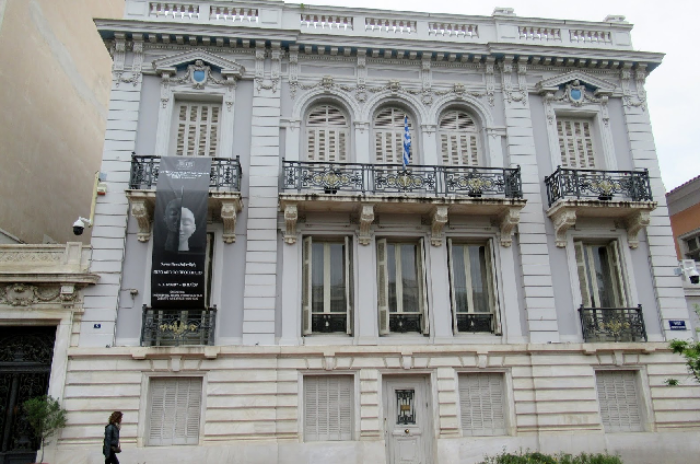
Vouros–Ephtaxias Residence – The Museum of the City of Athens
Comprised of the Dekozi-Vouros Residence and the Ephtaxias Residence, this twin building complex on Paparrigopoulou Street, in Klafthmonos Square, houses the Museum of the City of Athens. Built in 1834 from designs by German architects Lunder and Hoffer, its construction had been commissioned by Dekozi-Vouros, a banker from Chios. Being one of the first new buildings constructed in the city, it remains a superb example of the architectural style known as early classicism. When completed, the building overlooked the still-unrepaired square, where the remnants of the heavily damaged, Hasseki wall, were visible.
This building was home to King Otto and Queen Amalia from 1837 until 1843 when they moved to their newly built Palace. After World War II, the entire structure was restored, along with the connecting Ephtaxias Residence. All reconstruction was based on a study by distinguished architect, Ioannis Travlos. Today it houses the Museum of the City of Athens, showcasing the history of the city, from its declaration as the country’s capital, until today.

The National Gardens
The National Garden is a luscious parkland located in the heart of Athens, next to the Parliament Building, and very close to Syntagma Square, with entrances from Amalias Avenue, the Zappeion, Irodou Attikou Street, and Vasilissis Sofias Street. Founded by Queen Amalia in 1836, the ”Royal Palace Gardens” were initially planted by Bavarian horticultural specialists. Known today as the National Gardens, this spacious park is a thriving botanical paradise, containing an impressive array of local fauna.
Whether strolling leisurely along its paths or simply meditating in one of the little coves, nestled amongst the remnants of ancient buildings, the experience is uniquely peaceful — even pleasantly ironic, considering that you are literally surrounded by a bustling metropolis. Augmenting the experience are the exquisite sculptures and busts of important Greeks, all accompanied by the songs of the thousands of birds who live here. In the past, the Gardens also included a small but interesting Zoo, with animals mostly native to Greece.

The University of Athens
Founded in 1839, the University of Athens was built from the designs of Christian Hanssen, the brilliant architect, who desired to construct buildings that would not only adhere to the principles of Neo-Classicism but would also complement the contemporary architecture of the city. Completed in 1864, the building had been blessed by the participation of many other fine architects, including Kaftantzoglou and Theophilas.
And the funding required for such a massive project was supplied by multitudes of proud Greeks from the diaspora. The murals on the facade frieze were designed by the Bavarian Rahl, but painted by Polish artist Lebientzki, after Rahl’s death. The building’s facade is decorated with the busts of Rigas Feraios, the Patriarch Gregorios V, Adamantions Korais, Gladstone, and Ioannis Kapodistrias. When the Library and the Academy were finally completed, flanking both sides of the first structure, the “Athens Trilogy” of Neo-Classicism had been born.

The Old Palace, the Hellenic Parliament
Founded in 1839, the University of Athens was built from the designs of Christian Hanssen, the brilliant architect, who desired to construct buildings that would not only adhere to the principles of Neo-classicism but would also complement the contemporary architecture of the city. Completed in 1864, the building had been blessed by the participation of many other fine architects, including Kaftantzoglou and Theophilas.
And the funding required for such a massive project was supplied by multitudes of proud Greeks from the diaspora. The murals on the facade frieze were designed by the Bavarian Rahl, but painted by Polish artist Lebientzki, after Rahl’s death. The building’s facade is decorated with the busts of Rigas Feraios, the Patriarch Gregorios V, Adamantions Korais, Gladstone, and Ioannis Kapodistrias. When the Library and the Academy were finally completed, flanking both sides of the first structure, the “Athens Trilogy” of Neo-classicism had been born.

Syntagma Square
Syntagma Square is the central city square of Athens, located directly opposite the Parliament Building, formerly known as the old Royal Palace. The original name given to it during the planning of Athens was the “Square of the Muses.” However, after the Palace was erected, it was renamed, the Palace Square. But on September 3rd, 1843, following a boisterous public rally demanding that a constitution be established, it was again renamed, this time, Syntagma (Constitution) Square. The square is bordered by Amalias Street, which runs directly in front of the Parliament building and the Monument of the Unknown Soldier, Vassileos Georgiou I Street to the north, Philellinon Street on the west, and Othonos Street to the south. Beneath the square is the Syntagma Metro station.
It is worth mentioning that the numbering of the streets in Athens starts from Syntagma, and all distances to the major cities of Greece are measured from Syntagma, as well. Due to its extreme proximity to the original Palace and the current Parliament building, the square has been at the centre of many major political and social events, such as the 3rd of September revolution, the raucous rallies on the day of Greece’s liberation from the Germans on October 12, 1944, the civil war events of December, 1944 and, naturally, most political speeches given by party leaders during election times.
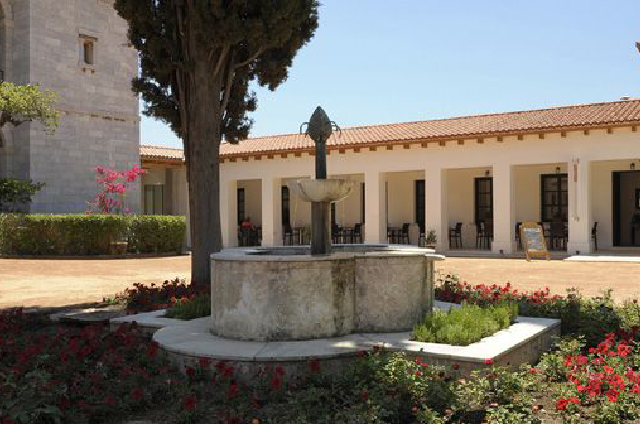
Byzantine Museum
The Byzantine and Christian Museum on Vasilissis Sofias Street is one of the most important Byzantine and post-Byzantine era museums in the world, with more than 25.000 objects dating from the 2nd century A.C. to the present. Containing exhibits acquired not only from Greece but from Asia Minor and the Balkans as well, the museum, housed in the Villa Ilissia, is a magnificent example of 19th-century architecture, dating from the earliest years of Greece’s liberation.
Designed by renowned Greek architect, Stamatios Kleanthis, the complex was originally built for the Duchess of Placentia, who had lived in Athens for many years. The main structure, a two-story building with a basement, was the Duchess’ primary residence. After her death, ownership of the property was transferred to the state, along with the other buildings in the complex. In 1926 the complex was assigned to house the Byzantine and Christian Museum and, after necessary alterations, opened its doors.

The Academy of Athens
This imposing, archaic building was built from 1859 until 1885 and was sponsored by the family of business entrepreneur, Baron Simon Sinas, who then lived in Vienna. Based on plans by Danish architect, Theophile Hanssen, and supervised by Ernst Ziller, the precise location of the construction site had already been selected in 1842, specifically chosen to be part of the famous “Athenian trilogy” of neo-classical buildings.
Based on Ionian era designs, the building is covered in white Pentelic marble, and its pediments are adorned with Peiraic stone; statues of Athena, goddess of Letters, and Apollo, god of the Arts, both created by Leonidas Drossis, are seen standing on two high Ionic order columns overlooking the entrance. Two other impressive statues greet visitors at the entrance escalade, Plato and Aristotle. Though originally drawn by Drossis, these two statues were not completed until after his death. Although the building was ready for occupancy in 1885, the Academy was not officially founded until 1926, when it commenced operations as the supreme research establishment in the country.

Anafiotika
The Anafiotika, one of the oldest neighbourhoods in Athens, was built on the northern slope of the Acropolis by workers and craftsmen from the Cyclades, mostly Anafi. They had flocked to the capital of the new, independent state of Greece, to work at the myriad construction projects underway at the time and, ideally, the massive project at King Otto’s Palace. Local traditions mention Damigos and Sigalas from Anafi as being this neighbourhood’s first inhabitants, followed soon by many more. Tolerated by the authorities, these newcomers started building their homes as they always had in the Cyclades, with their flat roofs connected, and creating a labyrinth of narrow uphill streets, with little stairways carved out of the rock. The whole neighbourhood took on the appearance of a Cycladic installation. From 1862 until 1922 the new neighbourhood was inhabited almost solely by islanders from the Cyclades, but then refugees from Asia Minor arrived, making this their new home as well. The inhabitants then began refurbishing and repairing even the smallest, most derelict churches in the area; Ag. Georgios of the Rock, and Ag. Symeon, even adding new belfries. In the 1950s, part of the neighbourhood was demolished to make room for archaeological excavations. Today only a few houses remain, declared as listed buildings by the state.
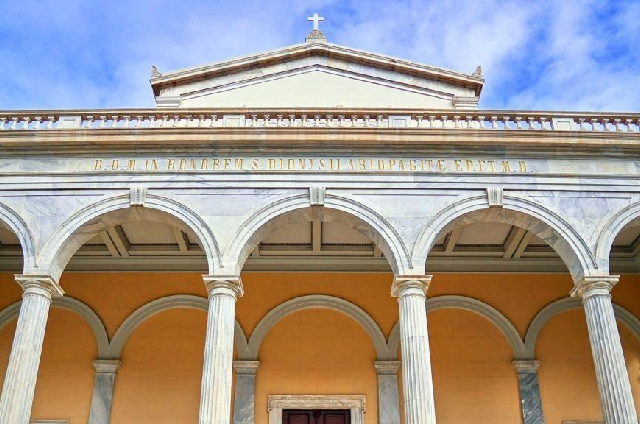
The Catholic Church of Ag. Dionysius
After many intrigues and adventures, the Athens Catholic Church was finally erected, at the junction of Panepistimiou and Omirou streets. Although the lot had been purchased in 1847, and all necessary studies completed by the distinguished German architect Klenzef, construction on the majestic, three-clite basilica didn’t begin until 1853 and was frequently interrupted due to the lack of funds. Then, in 1858 Lyssandros Kaftantzoglou undertook to resume the work, suggesting that a smaller, simpler version of the church be built, based on the original plans.
After eliminating the need for a belfry, and employing a more minimalistic approach, one more in tune with existing architectural forms of Athenian Neo-classicism, the church was soon finished. However, its gates didn’t open until 1865, three years after the ousting of King Otto. Additional work went on until 1875, when the Holy Altar, the entrance, the porch, the nearby archbishop’s residence, and other secondary buildings had been added to the complex. The vitreaux decorations were built in Munich, in the late 19th Century, and even more improvements were subsequently added. After 1960, an extensive restoration was performed to return the church to its original form.
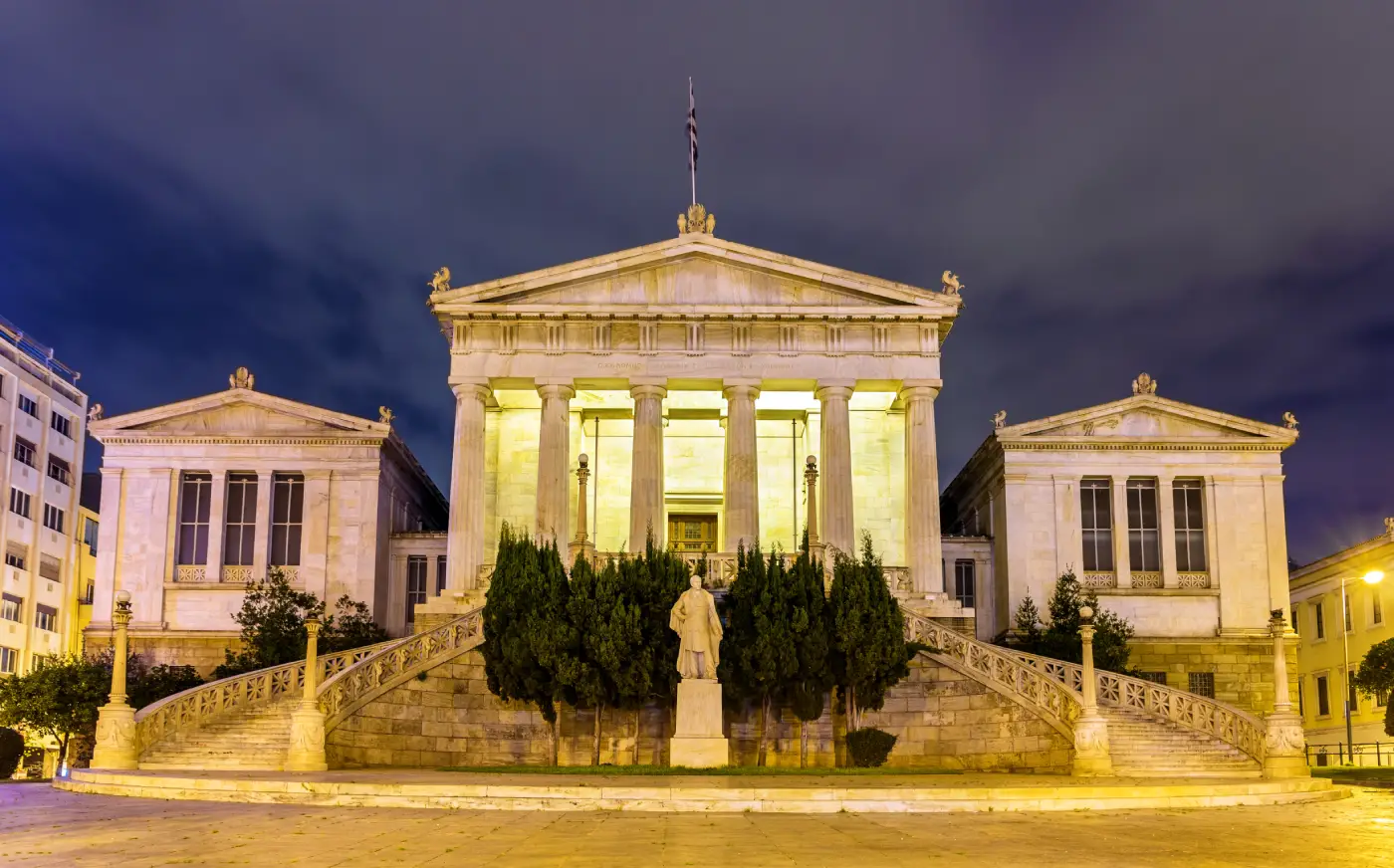
The National Library
The imposing building of the National Library is the easternmost of the three-building complex known as the Athenian Trilogy. Built in the 19th century to house the National Library, the University of Athens, and the Academy, the Library was designed by the famous architect, Theophil von Hansen, and financed by the Vallianos family, Greek businessmen of the diaspora. Constructed with white Pentelic marble, and enhanced by Doric columns, the building also boasts a stunning, renaissance-style, twin staircase.
The facade and vestibule are decorated with statues of the Vallianos family. It is worth noting that the National Library of Greece was originally established by Governor Ioannis Kapodistrias on the island of Aegina in 1829. At the time, the library’s vast collections were housed in numerous buildings, one of which was the small chapel of Agios Elefterios next to the Cathedral. Subsequently, even more library materials were housed in the University of Athens, the two collections finally being merged in 1866, and moved permanently to its current location in 1902.

The Athens Cathedral
Dedicated to the Annunciation of the Mother of God, The Athens Metropolitan Cathedral was built between 1842 and 1862, its three-aisled, domed basilica overlooks a street with the same name. Located a short distance from Syntagma Square, its design and construction were enhanced by the many famous architects who contributed their time and talents; Hanssen, Zezos, Boulanger, Kalkos and others. Additionally, numerous fine artists worked on both the exterior and interior decoration of the temple. Architectural materials and decorative pieces from derelict, byzantine churches and churches razed for archaeological reasons were also used in the Cathedral’s construction.
Since its inauguration, the Athens Cathedral has remained the site of many significant ceremonies, from the weddings of Kings to the funerals of important political and social figures. Following the massive earthquake that shook Athens in 1999, the Cathedral has been undergoing continuous maintenance and restoration. Services are therefore being temporarily held in the Church of St. Dionysius, in Kolonaki. The Cathedral houses the marble shrines containing the holy remnants of Agia Filothei and the Patriarch Gregorius V.

National Archaeological Museum
Situated in the heart of the city, the National Archaeological Museum on Patission Street, houses some of the most important artefacts of the ancient world, from the Neolithic era until the late Roman period; the treasure from the Antikythera wreck, Agamemnon’s death mask, the wall paintings of Thera, the Artemision Bronze, the Antikythera Ephebe, Nestor’s Cup, and the Marathon Boy are but a few of the important findings to be admired in the museum. Located in the facility’s southern annexe is the Epigraphical Museum, safeguarding the world’s largest collection of ancient Greek inscriptions.
Covering an entire city block, and adjacent to Metsovion National Technical University, this massive museum complex was designed and built according to the Neo-classic, architectural style prevailing in Greece and Europe during the 19th Century. A walk around the artefacts and collections exhibited in the museum is, quite simply, an awe-inspiring experience. To wind down, take a stroll around the large, neo-classic garden located in the front and at the side of the museum.

Panathenaic Stadium
The impressive Panathenaic Stadium is also known as Kallimarmaro (“the one made with beautiful marble”). Founded in the 4th century under the rule of Lycourgos, on the slopes of Ardittos Hill, it was restored and expanded by Hadrian Atticus. Following the city’s decline during the Christian era, and the Franc and Ottoman occupations, the stadium gradually fell into disrepair, eventually being buried under tons of dirt.
But the site was excavated and the ancient stadium was fully restored in time to host the first Modern Olympic Games in 1896. Since that time, the stadium has been connected to all major sports events in Greece. As a tribute to the original Marathon run, the Marathon International road race, held annually to commemorate Spyros Louis’ marathon victory at the first modern Olympic Games, ends here. The stadium was also the finishing point of the Athens, 2004 Olympic Games Marathon.
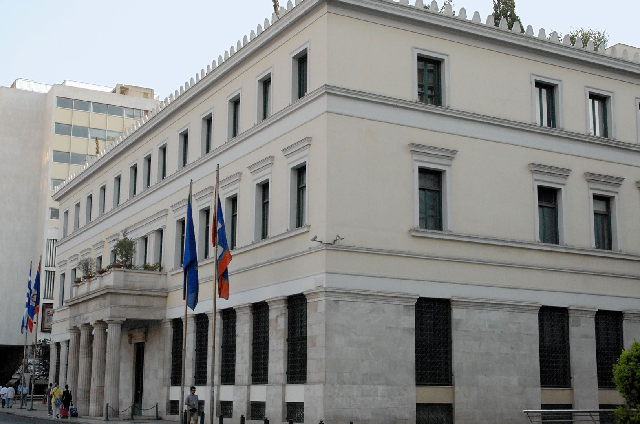
The Old City Hall
Designed by architect Panagiotis Kalkos, the old City Hall on Athenas Street was built between 1871 and 1874, during the mayoral reign of P. Kyrakos. Initially constructed as a two-story building with a tile roof and Doric order entrance, it was aesthetically and architecturally related to the adjacent Varvakeios School, a Neo-Classical building, also designed by Kalkos, which was destroyed in 1944.
In the 20th Century, City Hall underwent multiple renovations under mayors Spyros Merkouris in 1901, and Amvrossios Plytas between 1935 and 1937. A third floor was added to the building and extensive work was done on its exterior decoration. In the late 20th Century, the building was declared a listed building, and some of its exterior decorative elements were restored to their 19th-century style.
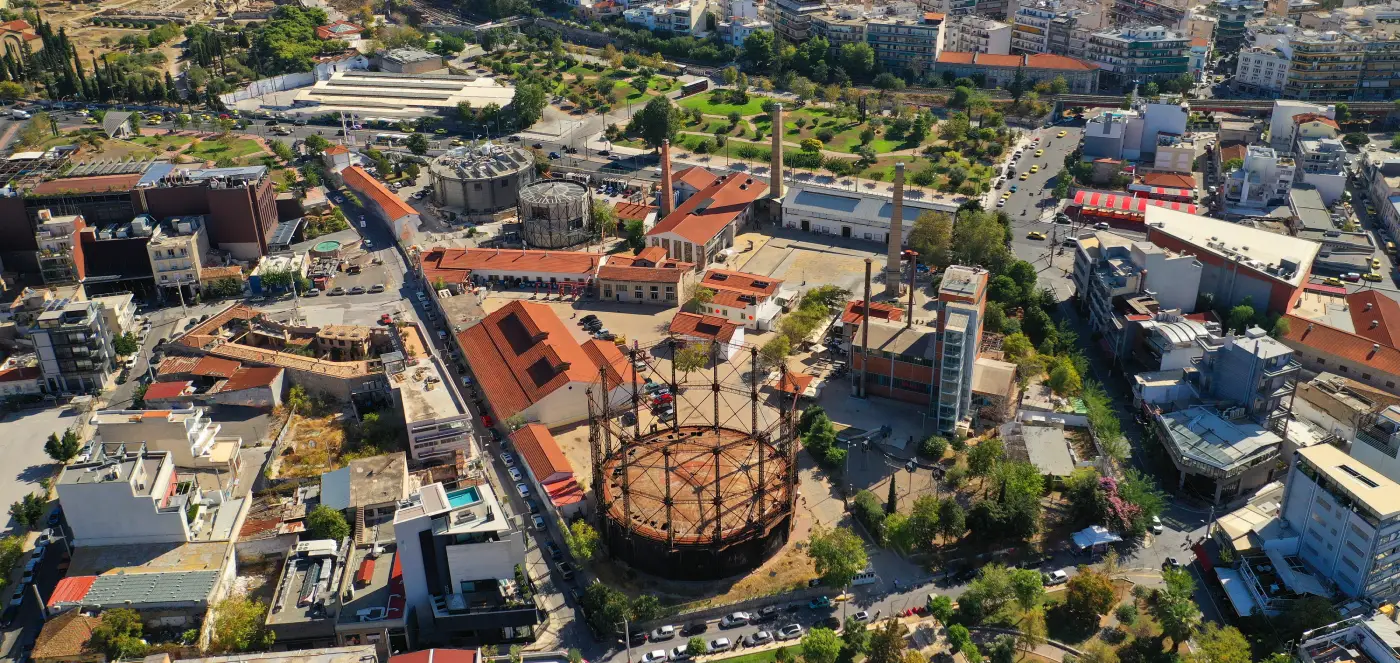
The Gasworks Plant (Gazi)
The Athens Gasworks factory, or “Gazi” as most people call it, is on the right side of Pireos Street, immediately past the entrance to Iera Odos. Built around 1860, the first plant was quite small and was owned by businessman, Frangiskos Feraldis. The small plant expanded rapidly, becoming an immense industrial complex. And though its general design mirrored the same architectural principles seen in similar industrial buildings throughout Europe, modernist decorative elements were also present, some displayed on the huge metal frames of the structures.
The plant was eventually sold to the Gas Lighting Company, and in 1938 it was acclaimed by the Municipality of Athens, finally ceasing operations in 1984. Today, the area has been fully refurbished and modernized into a “Technopolis-Gazi” cultural venue, home to various cultural events organized by the Municipality.
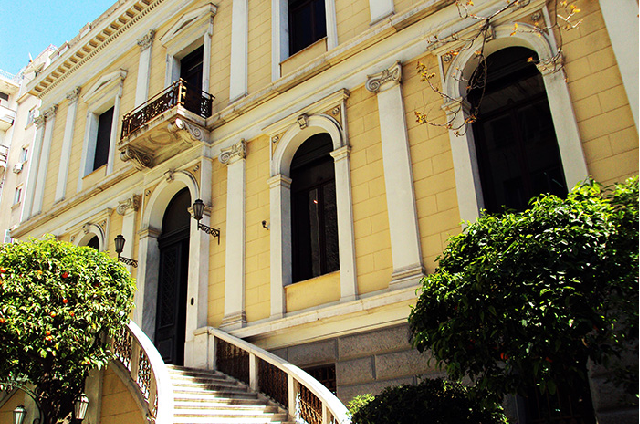
Iliou Melathron
This impressive, three-story mansion on Panepistimiou Street was built between 1878 and 1880 for the distinguished German businessman and amateur archaeologist, Heinrich Schliemann, who discovered ancient Troy and ancient Mycenae. At the time of its construction, it was deemed to be the most expensive private building in the city, as well as being one of the finest samples of the work of architect, Ziller. While applying the architectural principles of the Italian, Neo-Renaissance style, such as the use of consecutive arches on the facade, Ziller did not turn his back on the elements of Athenian Neo-Classicism; friezes, corbels, jambs and other Archaic elements.
In 1927 the mansion became the property of the Hellenic State, housing many public services, including the Supreme Court, from 1934 to 1982, which gave the building its new name, Areopagus. Before World War II, due to the possible danger of collapse, the statues on the facade were removed. In the 1980s, based on a study by Ersi Missailidou-Philipopoulou, Moschoula Chryssoulaki and Vasillis Handakas, a first attempt at restoration was made to establish a permanent home for the Numismatic Museum. The building was finally restored before the Athens Olympic Games.
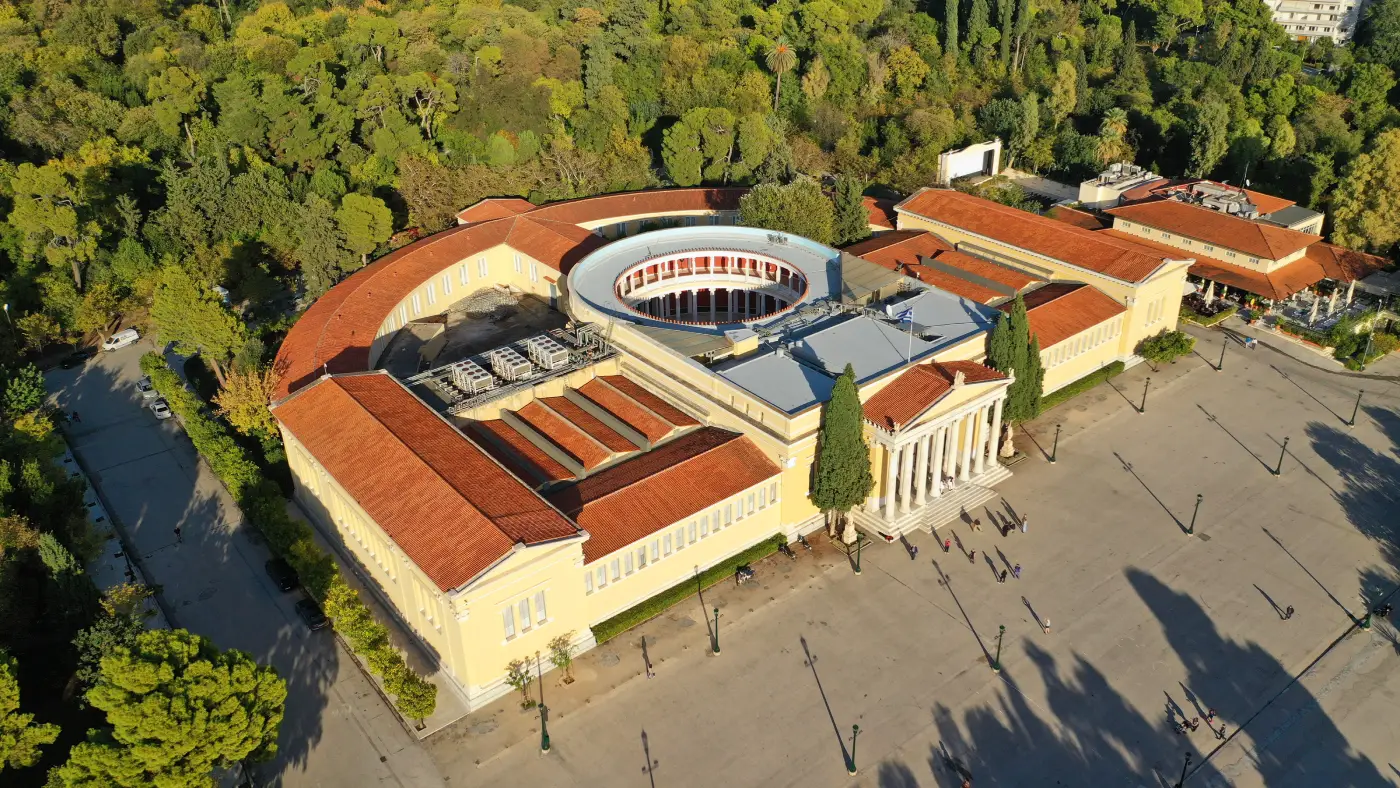
Zappeion
Located next to the National Gardens, the Zappeion Mansion, or simply, “Zappeion,” as it is called by the locals, is one of the most impressive and important historical buildings in Athens. As early as 1859, the Greek Government had been contemplating renovation of the structure, using plans drawn up by Greek architect, Theophilas and his French counterpart, Boulanger. And though well-funded by Greek benefactor, Evangelos Zappas, the project never quite got off the ground.
Eventually, however, Danish architect Hanssen became involved and the project was finally given the green light. The official inauguration took place in 1888 and since then, this building has become one of the primary symbols of modern Athens. During its tenure, the building has been home to an eclectic variety of functions; exhibitions, official ceremonies, the first modern Olympic Games of 1896, and in 1936, the Hellenic Radio Station. Today it serves as a press center for political parties during elections.

The Monastiraki Metro Station
Built between 1890-1895, the Monastiraki subway station became the first steam-train railway connecting Athens and Piraeus. Having operated locally since 1869, its main terminal was located in Thission, and its extension to Monastiraki was built by businessman, Stephanos Psihas. During construction, extensive archaeological excavations were conducted, revealing a plethora of interesting relics, many of which are still present today.
Passengers travelling from Thission to the new station will see many ancient relics and remnants of the city’s historic past. In 1904, the steam trains were converted to electricity, and from 1926 to 1930 the line was further extended, tunnelling from Monastiraki to the Omonia station. In 2000 this station, along with all of the other older stations, was fully refurbished, an architectural gem, displaying myriad antiquities.
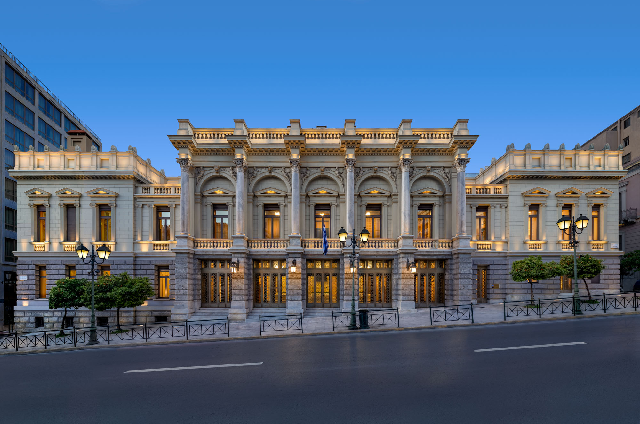
The National Theatre
The National Theatre on Agiou Konstantinou Street, near the Omonia Square, was built to meet the city’s need for a new theatre. Designed by Hernst Ziller and constructed from 1891 to 1901, the project was initiated by King Georg I.
Located on a small lot purchased by Bavarian courtesan, Thonn, private funding for its construction was supplied by a large number of wealthy Greek patrons, most of them from the diaspora; Rallis, Korgialenios and Evgenidis. Despite the challenges posed by the small size of the property and the extreme land gradient, the architect delivered a splendid building of the Eclectisistic order, a truly magnificent theatre, containing two full stages and a large lecture room. The National Theatre is admired by Greek and international audiences alike.

Stathatos Manor
The Stathatos Manor in Kolonaki is located at the junction of Vasilissis Sofias and Irodotou 1 streets, where it houses a wing of the Cycladic Art Museum. Built in the late 19th Century by famous architect, Hernst Ziller, the manor was based on plans drawn in 1895 for an expatriate merchant from Ithaca by the name of Stathatos, who, along with his wife, used the manor as their residence. During the 1930’s the building saw extensive alterations and a complete interior renovation.
After World War II it was used as an embassy, until 1981 when it became the property of the Hellenic State. The Government initially intended to convert the building into a guest house for distinguished visitors, so the manor was again fully refurbished, this time being restored to its original design. It was eventually assigned to the Cycladic Art Museum.
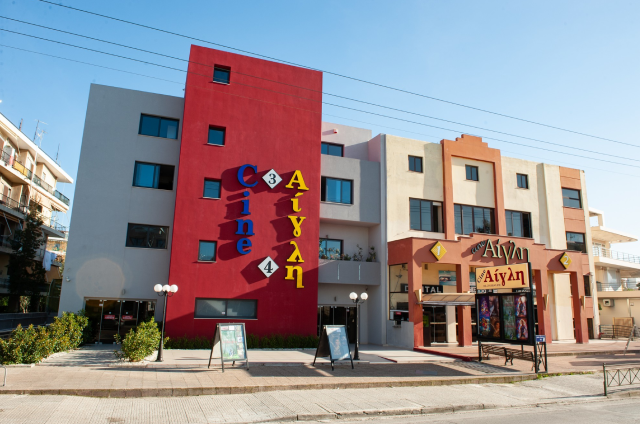
Egli Cinema
The Egli Cinema is perhaps the oldest still in operation in Athens. Opened in the early 20th Century, following a civil war and World War I, it is located on the premises of the “Egli Beer Restaurant,” which opened in 1904. The theatre’s proximity to the Zappeion Mansion and its gardens helps to augment this picturesque section of old Athens. The cinema, now part of the large Egli multiplex, with its restaurants, bars, coffee shops, and event venues, is considered by summer cinema lovers, to be one of the best places for entertainment in Athens.
And, though located in the very centre of Athens, it is virtually free from the usual noise associated with bustling cities. Surrounded by lush greenery, complemented by the perfume of summer flowers, it even has a “private” veranda, from which, you can watch your favourite movies while enjoying a great dinner.
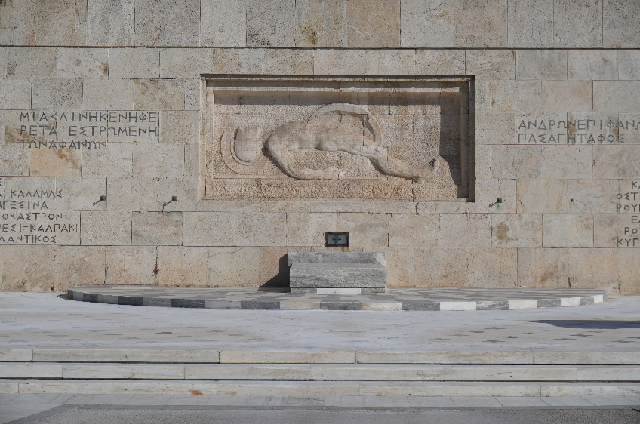
The Monument of the Unknown Soldier
In the late 1920s, architects E. Lazaridis and E. Dimitriades Rok designed the Monument of the Unknown Soldier. The relief figure on the marble tomb was sculpted by famed artist, Konstantinos Dimitriades. During the initial phases of its construction, before its final placement, extensive excavation was undertaken in front of the Parliament building, lowering the ground level by approximately 6 metres, to the level of Amalias Avenue.
Heavily influenced by the archaic art style, the monument is strictly minimalist in design, its only modernist decorative elements being the bronze shields. The monument is guarded day and night by the Presidential Guard of Evzones and is where officials dedicate wreaths in honour of the Unknown Soldier.
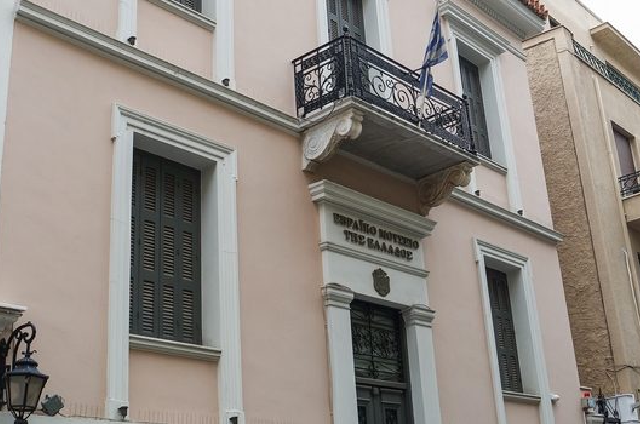
Jewish Museum
The Jewish Museum of Greece was founded in 1977 by the Jewish Community of Athens. Housed in a room of the Synagogue on Melidoni Street, this small museum contains objects that survived World War II; objects from the everyday lives of Greek Jews, mostly small works of art, historic documents and heirlooms. A large part of the original collection were items seized by the Bulgarians in Salonika, and returned to Greece by the Bulgarian Government after the war.
Over the years, a large volume of material was collected; rare editions of books, valuable fabrics, jewellery, religious and ornamental vessels, and simple, everyday objects. When the ever-increasing volume of exhibits demanded new, larger premises for the museum, the curators rented a floor in a building on Amalias Street, which is now open to the public. In 1989 the museum became a legal entity, administered by a seven-member council. In the 1990’s the museum’s current location on 39, Nikis Street, was purchased and restored, and the museum moved in permanently.

The Ermou Pedestrian Street
The Ermou Pedestrian Street
Ermou Street
Ermou Street is a thriving pedestrian destination with a great history. Combining modern commercial activity with the function of an old town main street, the Ermou pedestrian street starts to the west of Syntagma Square and leads to Monastiraki. Its bustling sidewalks are lined with large stores, boutique designer shops, little snack bars, coffee shops, and, of course, people.
Located approximately in the middle of the pedestrian street is the historic 11th Century Kapnikarea, with its beautiful murals by Fotis Kondoglou. Ermou Street is considered to be the most frequented — and most expensive commercial street in Greece.

OAKA – The Olympic Athletic Center of Athens
The Olympic Athletic Center of Athens bears the name of the first winner of the Marathon in the first modern Olympic Games in Athens in 1896, the notorious Spyros Louis, who was a simple waterman from Maroussi. The construction of the premises started in 1978 and the main Stadium and the other installations were inaugurated four years later to house the European Athletics Championship in 1982.
In the following years, many other sports facilities surrounded the Main Olympic Stadium: the Olympic Velodrome (inaugurated in 1991), the Olympic Aquatics Center (1991), the Olympic Indoor Sports Center (1995), the Olympic Tennis Center (2004), as well as other supplementary sports facilities. The Olympic Athletic Center of Athens is a state-of-the-art sports facility, which greatly promotes sports activities in Greece. The facilities were finalised in 2004, with the redevelopment additions by the Spanish architect Calatrava, and the Stadium hosted the Athens 28th Olympic Games in 2004.
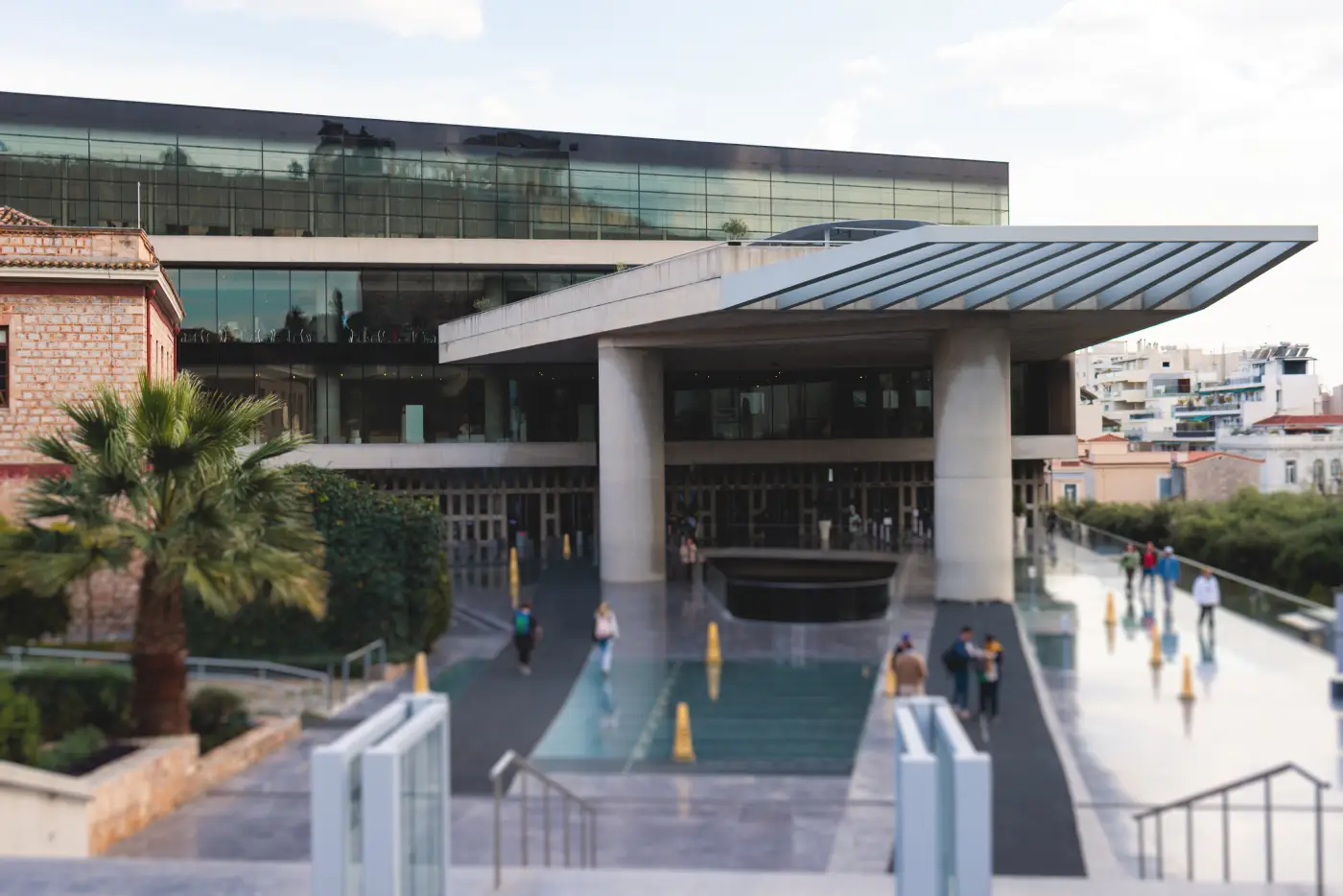
New Acropolis Museum
With a subway station conveniently located near its front entrance, the New Acropolis Museum contains the most important artefacts found on the “sacred rock.” Containing rare objects from the Mycenaean era to the Roman and early Christian ages, it is an absolute “must-see” for visitors. Since Opening in 2009, millions of visitors have gazed in wonder at the Parthenon sculptures adorning its rooms. And, through the large overhead windows, visitors can simply look up to be overwhelmed by the sheer size and beauty of the ancient monuments towering above the museum.
Replacing the old museum that had operated since the 19th Century in the building complex adjacent to the Parthenon. the New Acropolis Museum displays its invaluable collection of ancient artefacts with a modern twist; Built on high pillars directly above the Roman era archaeological site, visitors can look down through the transparent floors to view these rare artefacts. It is worth noting that since many of the principal exhibits require special lighting conditions to ensure their preservation, the museum uses a substantial amount of natural light for its illumination.
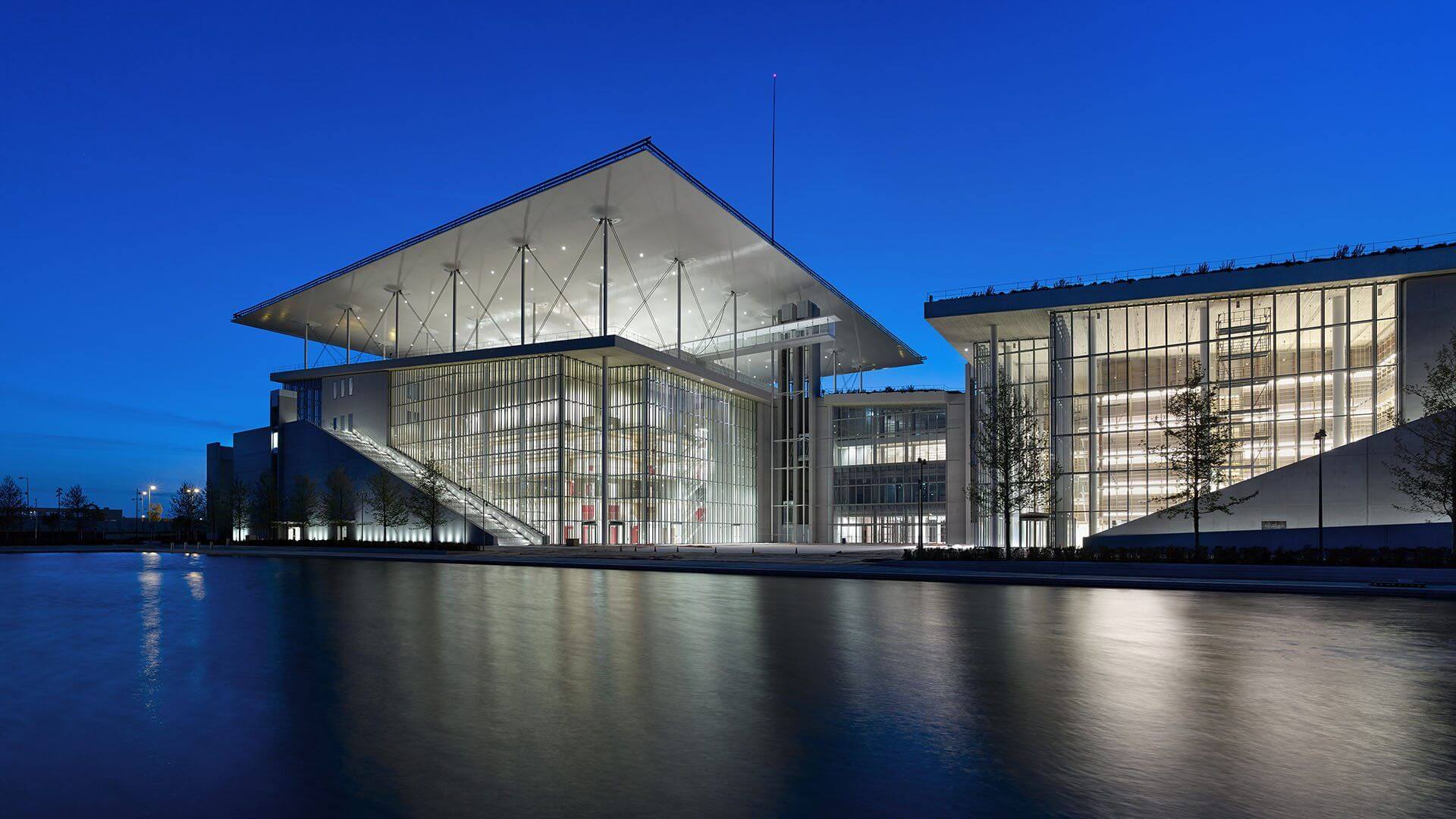
Stavros Niarchos Foundation Cultural Center (SNFCC)
Designed by architectural firm Renzo Piano Building Workshop, the Stavros Niarchos Foundation Cultural Center (SNFCC) is a sustainable world-class cultural, learning and recreational urban complex that includes the new homes of the National Library of Greece and the Greek National Opera, located within the Stavros Niarchos Park, one of the largest green spaces in Athens, covering an area of 210.000 square meters.
The SNFCC was constructed through a grant from the Stavros Niarchos Foundation. It was completed in 2016, and delivered to the Greek State in February 2017.
A global architectural landmark, a sustainability paradigm as well as a metropolitan cultural destination, hosting three cultural organizations under the same roof, the SNFCC aims to become a common ground, a place for all people, where everyone has access to learning, the arts and events that stimulate, engage and inspire.
The SNFCC is the first public-private partnership of its kind in Greece, and the largest cultural/educational project ever undertaken in the country. Additionally, it is one of the world’s most sustainable building complexes of its size. In November 2016, the SNFCC achieved the highest and most stringent international standard for sustainable design and construction – the Platinum LEED – for its innovative architecture and green technology.
To organize a tour or learn more about SNFCC and its events please visit SNFCC.org
Testimonials
What did the world say
Experiencing the “Domaine Vassiliou” winery in Attica
GRČKA / Atina – Novi muzej Akropolja (New Acropolis Museum)
umetnostputovanja.blogspot.comGrčka kuhinja
Один день в городе. Афины ? Моя Планета
Моя ПланетаDavid Owen: The original marathon is going from strength to strength. So why do the very best runners still stay away?
insidethegames.bizGrecia: ultimo mare in Attica. A Hydra, Aegina e Spetses A poca distanza da Atene,
tre perle che offrono spiagge sabbiose, templi da cui godersi il tramonto e relax totale
Grecia: tour sulle rotte del vino in Attica
HET GRIEKSE EILANDJE EGINA: CULTUUR EN PRACHTIGE STRANDEN OP EEN STEENWORP AFSTAND VAN ATHENE
viaggiandoconluca.itIntens genieten op het prachtige eiland Hydra
Greece Tourism presents Attica wine & food experience
eturbonews.comCosa fare ad Atene in un weekend
viaggiandoconluca.itVisitare il Centro Culturale Stavros Niarchos ad Atene
viaggiandoconluca.itSalire sull’acropoli di Atene per visitare il Partenone
viaggiandoconluca.itget out of athens!
homolkareist.comDownload PDF Athènes, éternelle et divine
Le Club VoyageDownload PDF Alte Steine in modernem Rahmen
TelecranHydra: It’s the most glamorous Greek island you’ve never heard of
metro.newsΗ Λίμνη της Βουλιαγμένης ένα γεωλογικό φαινόμενο
cyprushighlights.comΕπίσκεψη στον Αρχαιολογικό Χώρο Σουνίου
cyprushighlights.comΗ αποθέωση του Πολιτισμού & της Τέχνης στο Κέντρο Πολιτισμού του Ιδρύματος Σταύρος Νιάρχος
cyprushighlights.comΣτο μουσείο της Ακρόπολης μας μάγεψαν οι Καρυάτιδες
cyprushighlights.comΣυγκίνηση και σεβασμό στην αίθουσα του Παρθενώνα των Ελλήνων και της οικουμένης
cyprushighlights.comΗ διεύθυνση τουρισμού Περιφέρειας Αττικής τίμησε δημοσιογράφους που συμμετείχαν στο Attica Riviera
cyprushighlights.comΔημοσιογράφοι από την Ευρώπη συμμετείχαν σε δημοσιογραφικό γκρουπ με θεματική The Attica Riviera
cyprushighlights.comAtenas: uma viagem às nossas raízes
Nel cuore di Atene, tra storia e templi millenari
travelglobe.itOkay, Atene per un weekend è la meta (4 stagioni) che mette d’accordo tutti basta sapere dove andare e cosa vedere
elle.comAtene: nel futuristico Centro culturale della Fondazione Stavros Niarchos
linkviaggi.comALS GOD IN ATHENE
reisachtig.comAtene, sospesa tra il glorioso antico passato e il futuro
latitudinex.comDe geuren, kleuren en smaken van Attica
ongewoonlekker.comWINE & FOOD EXPERIENCE IN ATTICA – IN A CLASS OF ITS OWN
Attica, Storia, vino e natura nei dintorni di Atene
latitudinex.comAttica Experience, dove il mare ha il colore del vino
lagenziadiviaggi.itDiscovering hidden gems during the Wine and Gastronomic tour in Attica
Aus der Reihe „Unterwegs in Europa“: Attika
Experiencing the “Domaine Vassiliou” winery in Attica
A photo tour inside the “Gikas winery” in Attica
Is the sunset at Cape Sounion the best of Attica?
ATTICA WINE & FOOD EXPERIENCE
emotionsmagazine.comDiscover
Islands of Attica
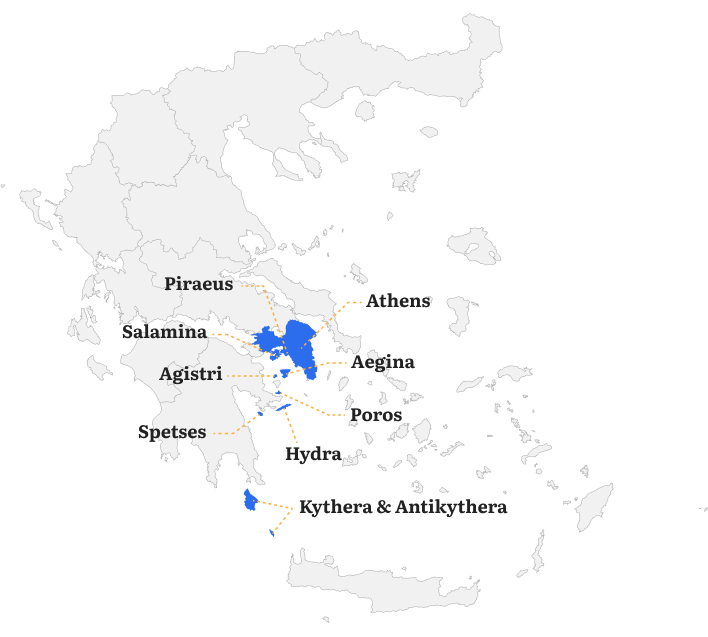

Attica's Islands


Aegina
Located in the heart of the Argo-Saronic Gulf, the island of Aegina is a favourite destination for Athenians and the perfect choice for tourists who visit Greece.


Agistri
Agistri is not just an island; it's a treasure trove of natural beauty and cherished moments.


Poros
On the southeastern coast of the Peloponnese opposite Attica is an area of considerable interest that includes the peninsula of Methana, Poros and Troizena.


Salamina
Discover the enchanting allure of Salamina, a hidden gem in the heart of the Saronic Gulf.


Spetses
Embark on a journey of charm and elegance on the island of Spetses, nestled in the beauty of the Saronic Gulf.


Hydra
Visiting Hydra is equivalent to a journey through the history, glory and splendor of one of the most beloved islands.

